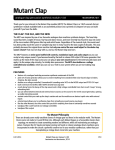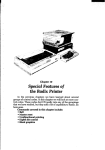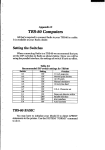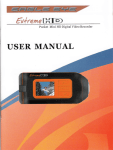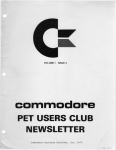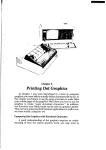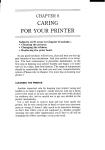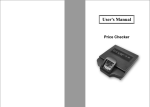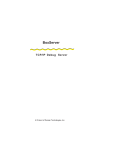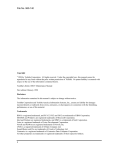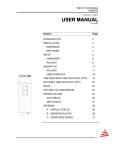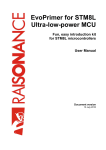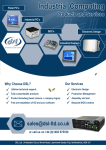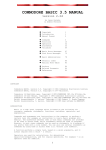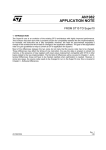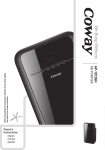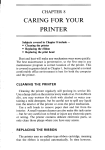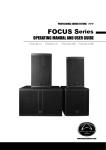Download Delta User`s Manual
Transcript
Appendix
F
Atari 4OO/8OOComputers
The best way to connect your Atari to Delta is with the Universal/Atari Parallel Interface by Star Micronics. It comes complete with its own cable. Or Delta will connect to the Atari 850
interface, using a cable that is available from your dealer.
Setting the switches
We recommend that you set the DIP switches in Delta as
shown below when connecting it to an Atari 400 or 800.
Recommended DIP Switch Settings for Atari
Switch
_..-----
Settine
Function
l-l
ON”
11 inch page size
l-2
ON
ON
Normal
1-3
1-4
ON
Normal
1-5
l/6 inch line feed
1-6
ON
ON
l-7
ON
U.S.A.
l-8
2-l
ON
ON
Paper-out
2-2
OFF
Parallel
2-3
OFF
8-bit interface
2-4
ON
Auto line feed
print density
10 CPI pitch
characters
Character
detector
set
active
interface
Using Atari BASIC
While the Atari computers don’t have any real problems in
using the full capabilities of Delta, there are a couple of fairly
unique things to keep in mind. Atari BASIC requires that all
strings be dimensioned. The maximum string length is 99 characters, so Atari users must break up their dot graphics strings into 99
character sections.
Delta
194
User’s
Manual
Atari 850 Interface Module Parallel Cable
Delta
1?in No.
Function
Atari 850
Pin No.
Function
1
STROBE
1
STROBE
2
DATA1
2
DATA1
3
DATA2
3
DATA2
4
DATA3
4
DATA3
5
DATA4
5
DATA4
6
DATA5
6
DATA5
7
DATA6
7
DATA6
8
DATA7
8
DATA7
16
SIG GND
11
SIG GND
11
BUSY
13
BUSY
9
DATA8
15
DATA8
To join two strings together, as when building a string of dot
graphics data, the following format must be used:
A$(LEN(A$)+l)=B$
(This adds B$ to the end of A$.)
The Atari adds spaces to print lines when you use the
LPRINT command. We recommend that you use the PRINT #
command instead. You must open the printer as a device first. For
example:
10 OPEN #4,8,p,"P"
2pIPRINT #4;"TESTING"
It’s a good idea to close the printer when your program is
done using it, like this:
90
CLOSE #4
Atari BASIC also requires that you use semicolons between
elements in a print statement where most BASICS will accept a
-
-
,.
c
Atari 4001800 Computers
195
space. Your print commands must look like this:
40 PRINT CHR$(27);"B"; CHR$(3);"CONDENSED"
Listing programs
Listing BASIC programs to Delta from an Atari computer is
relatively easy; just add “P:” to the normal LIST command so that
it looks like this:
LIST "P:"
Program listings
The following programs were translated
Atari 400 and 800 computers.
to work with the
Chart program
10 REM ATARI 400 & 80@ & 12&JXL
2@ DIM BL$(6),FD$(4)
30 TRUE=l:FALSE=@
100 OPEN #4,8,0,"P"
120 GOSUB 1@00
130 PRINT #~;"*REGuLAR*"
140 GOSUB 2000
150 PRINT #4;"*DOUBLESTRIKE*"
160 PRINT #4;CHR$(27);"G";
170 GOSUB 2000
180 PRINT #4;"*EMPHASIZED*":
190 EM=TRUE
2$fpl
GOSUB 2@@J
210 PRINT #4;"*DOUBLESTRIKE & EMPHASIZED*"
22@ PRINT #4;CHR$(27);"G";CHR$(27);"E";
23~ GOSUB 2gpg
240 CLOSE #4
25$lEND
lp00 PRINT #4;CHR$(27);"@"
l@lp,PRINT #4;CHR$(14);" NORMAL
ENLARGED "
1020 PRINT #4;CHR$(27);"-";CHR$(l);
1030 PRINT #4;CHR$(27);"B";CHR$(3);"CONDENSED
";
1040 PRINT #4;CHR$(27);"B";CHR$(2);"
ELITE ";
1050 PRINT #4;CHR$(27);"B";CHR$(l);"
PICA
";
1060 PRINT #4;CHR$(27);"B";CHR$(3);"CONDENSED
";
1070 PRINT #4;CHR$(27);"B";CHR$(2);"
ELITE ";
Delta User’s Manual
196
1080 PRINT #4;CHR$(27);"B";CHR$(l);"
PICA
"
1090 PRINT #4;CHR$(27);"@":RETURN
2000 IT=FALSE:PRINT
#4;CHR$(27);
“5”;
2010 UN=FALSE:PRINT#4;CHR$(27);"-";CHR$(p);
2020 EN=FALSE:PRINT#4;CHR$(27);"W";CHR$(@);
2030 PI=FALSE
2040 PRINT #4;CHR$(27);"B";CHR$(3);:GOSUB
2130
2050 PRINT #4;CHR$(27);"B";CHR$(2);:GOSUB
2130
2060 PRINT #4;CHR$(27);"B";CHR$(l);:PI=TRUE:GOSUB
2130
2070 IF EN=TRUETHEN PRINT #4:GOTO2090
2080 PRINT #4;CHR$(27);"W";CHR$(l);:EN=TRUE:GOTO
2030
2090 IF UN=TRUETHEN PRINT #4:GOTO2110
"-";CHR$(l);:UN=TRUE:GOTO
2100 PRINT #4;CHR$(27);
2020
2110 IF IT=TRUETHEN PRINT #4;CHR$(27);"@":RETURN
2120 PRINT #4;CHR$(27);"4";:IT=TRUE:GOTO
2010
":FD$="...."
2130 BL$="
2140 IF EM=FALSETHEN PRINT #4;"ABcd";:GOTO
2190
2150 IF PI=FALSETHEN PRINT #4;FD$;:GOTO2170
2160 PRINT #4;"ABcd";
2170 IF EN=TRUETHEN PRINT #4;” ";:RETURN
2180 IF EN=FALSETHEN PRINT #4;BL$;:RETURN
2190 IF EN=TRUETHEN PRINT #4;” ";:RETURN
2200 PRINT #4;CHR$(27);"S";CHR$(@);"Xx";
2210 PRINT #4;CHR$(27);"S";CHR$(l);"Yy";"
";
2220 PRINT #4;CHR$(27);"T";
2230 RETURN
-
-
1
-.
-
--
Special character chart program
10 REM PRINT SPECIAL CHAR.SET
20 OPEN #4,8,0, "P"
30 FOR J=l60 to 255 STEP 8
40 FOR I=J TO J+7
50 PRINT #4;1;"= ";CHR$(I);" ";
60 NEXT 1:PRINT#4:NEXTJ
70 CLOSE #4
-
Macro program
5 REM DEFINE MACRO INSTRUCTION
10 OPEN #4,8,0,"P"
20 PRINT #4,CHR$(27);"+";
30 PRINT #4,~~~$(18);
Atari 4OOl800 Comrmters
197
40 PRINT #4,CHR$(27);"W";CHR$(@);
50 PRINT #4,CHR$(27);"F";
60 PRINT #4,CHR$(27);"H";
70 PRINT #4,CHR$(27);"-";CHR$(@;
80 PRINT #4,CHR$(27);"T";
90 PRINT #4,CHR$(27);"5";
95 PRINT #4,CHR$(jO)
L
Bridge hand program
10 OPEN #4,8,0,"P"
20 GOSUB 1000
30 GOSUB 2000
40 GOSUB 3000
50 GOSUB 4000
60 CLOSE #4
70 END
1000 REM INITIALIZEVARIABLES
1010 DIM HA(4),DE(52>,CA$(50),SU$(20)
1020 SU$="SHDc"
1030 CA$=" 23456789lCJQKA
II
1035 FOR I=0 TO 4:HA(I)=@:NEXTI
1040 RETURN
2000 REM INITIALIZEPRINTER
2010 PRINT #4;CHR$(27);CHR$(68);CHR$(20);CHR$(40);
CHs(0)
""2fP;;;; #4;CHR$(27);CHR$(43);CHR$(27);CHR$(36);
.
2030 PRINT'#4;CHR$(27);CHR$(69);CHR$(30)
2035 PRINT #4;CHR$(27);CHR$(42);CHR$(@)
2040 FOR I=1 TO 4
2050 PRINT #4;CHR$(27);CHR$(42);CHR$(l);
2060 FOR J=l TO 13
2070 READ X:PRINT #4;CHR$(X);
2080 NEXT J
2090 NEXT I
2100 PRINT #4
2110 RETURN
2120 DATA 72,11,4,1~,2~,10,52,72,52,1~,2~,1~,4
2130 DATA 83,11,16,8,2~,8,86,41,86,8,2~,8,16
2148 DATA 67,11,8,16,8,18,65,62,65,18,8,16,8
2150 DATA 68,11,8,0,28,0,62,65,62,0,28,0,8
30@0 REM DEAL CARD
3010 FOR CA=1 TO 52
A
: i
.’
,,
-
198
Delta User’s Manual
3020 X=INT(RND(0)*4+1)
3030 IF HA(X)=13THEN 3020
3035 HA(X)=HA(X)+l
3040 DE(CA)=X
3050 NEXT CA
3060 RETURN
4000 REM PRINT FOUR HANDS
);"NORTH"
4010 PRINT #4;CHR$(27);"!";CHR$(9
);CHR$(27);
4020 PRINT #4;CHR$(27);"$";CHR$(l
CHR$(70);
4030 HA=1
4040 FOR SU=@ TO 3
4050 PRINT #4;CHR$(9);
4060 GOSUB 4300
4070 PRINT #4
4080 NEXT SU
*"!";"WEST";CHR$(9);CHR$(9);
4090 PRINT #4;CHR$(27),
"EAST"
4100 PRINT #4;CHR$(27);"$";CHR$(l);CHR$(27);
CHW(70);
4110 FOR SU=plTO 3
4120 HA=2
4130 GOSUB 4300
4140 PRINT #4;CHR$(9);CHR$(9);
4150 HA=3
4160 GOSUB 4300
4170 PRINT #4
4180 NEXT SU
4190 PRINT #4;CHR$(27);"!";CHR$(9);"SOUTH"
4200 PRINT #4;CHR$(27);"$";CHR$(lj;CHR$(27);
cm$(70);
4210 HA=4
4220 FOR SU=@ TO 3
4230 PRINT #4;CHR$(9);
4240 GOSUB 4300
4250 PRINT #4
4260 NEXT SU
4270 PRINT #4;CHR$(27);"$";CHR$(0j;CHR$(27j;CHR$(70)
4280 RETURN
4290 REM PRINT ONE LINE
4300 PRINT #4;SU$(SU+l,SU+l);
4310 FOR CA=13 TO 1 STEP -1
4320 IF DE(SU*13+CA)=HA
THEN PRINT #4;
CA$(CA*3,CA*3+2);
-
.-
-
‘,
._,
“:
,. . :
Atari 4OOl800 Computers
4330 NEXT CA
4340 RETURN
Numeral program
10 REM PROGRAMTO DEFINE AND PRINT NUMERALS
OPEN #4,8,0,"P"
30 FOR ~1=16g To 200
40 PRINT #4;CHR$(27);CHR$(42);CHR$(
50 PRINT #4;CHR$(Nl);
60 READ N2
70 PRINT #4;CHR$(N2);
80 FOR S=l TO 11
90 READ MS
100 PRINT#4;CHR$(MS);
110 NEXT S
120 NEXT Nl
130 PRINT #4;CHR$(27);CHR$(88);CHR$(l)
135 PRINT #4;CHR$(27);"l"
140 FOR I=160 TO 200 STEP 4
150 PRINT #4;CHR$(I);CHR$(I+l);CHR$(2@);
160 NEXT I
165 PRINT #4
170 FOR I=162 TO 200 STEP 4
180 PRINT #4;CHR$(I);CHR$(I+l);CHR$(200);
190 NEXT I
200 PRINT #4;CHR$(27);"@"
210 CLOSE #4
220 END
340 REM ZERO
350 DATA 11,0,96,16,104,16,44,30,14,0,2,1
360 DATA 11,2,1,2,1,6,8,38,88,32,8,32
370 DATA 11,3,12,9,12,51,0,96,0,96,0,96
380 DATA 11,0,32,0,48,0,28,3,12,3,4,3
390 REM ONE
400 DATA 11,0,0,0,0,0,4,0,4,0,4>126
410 DATA 9,12,114,12,114,12,2,0,0,0,0,0
420 DATA 11,64,~,64,~,64,~,64,32,8~,47,80
430 DATA 9,47,80,47,64,0,64,0,64,0,0,0
440 REM TWO
450 DATA 11,0,0,0,0,0,12,16,14,0,6,0
460 DATA 11,3,0,3,0,70,56,70,56,4,24,0
470 DATA 11,64,0,64,32,64,32,80,32,80,40,64
480 DATA 11,44,64,38,65,34,65,32,80,32,88,0
490 REM THREE
2i
--
199
Delta User’s Manual
200
-
500 DATA11,0,0,0,0,0,0,4,2,4,2,4
510 DATA 11,34,84,34,92,34,76,34,68,2,64,0
520 DATA 11,16,0,48,0,56,64,48,64,32,64,32
530 DATA 11,64,32,64,48,9,54,22,9,6,1
540 REM FOUR
550 DATA 11,0,0,0,0,0,0,64,36,88,32,16
560 DATA 11,0,0,64,32,64,56,64,60,2,12,0
570 DATA 11,0,8,4,10,5,10,5,8,4,72,4
580 DATA 11,88,38,89,38,89,6,73,4,8,6,0
590 REM FIVE
600 DATA11,0,0,0,0,64,32,84,50,76,34,68
610 DATA 10,34,68,34,68,34,68,2,68,2,0,0
620 DATA10,0,32,24,101,24,97,0,64,0,64,0
-
630 DATA 11,64,0,96,1,48,15,48,15,16,15,0
640 REM SIX
-
650 DATA11,0,96,0,112,0,120,0,92,0,102,0
660 DATA11,98,0,98,0,98,0,70,0,14,0,6
670 DATA 11,7,8,23,8,55,8,99,0,65,0,64
680 DATA11,0,96,0,112,1,62,1,30,1,14,0
690 REM SEVEN
700 DATA 11,0,16,8,6,8,6,8,6,8,6,8
710 DATA9,70,8,102,8,54,8,6,0,2,0,0
720 DATA11,0,64,0,96,0,120,0,124,0,30,1
730 DATA9,6,1,0,0,0,0,0,0,0,0,0
740 REM EIGHT
750 DATA11,0,0,0,0,24,36,24,102,24,102,0
760 DATA 11,67,0,67,0,99,28,34,28,34,28,0
770 DATA 11,12,18,44,19,108,19,96,1,64,0,64
780 DATA 11,0,96,1,112,15,48,15,16,14,0,0
790 REM NINE
800 DATA11,0,0,120,4,120,6,120,6,0,3,0
810 DATA 11,3,0,3,0,67,4,123,4,122,4,120
820 DATA 11,48,0,56,0,113,0,99,0,99,0,99
830 DATA11,0,115,0,57,0,31,0,15,0,7,0
840 REM SPACE
850 DATA11,0,0,0,0,0,0,0,0,0,0,0
Download u tiii ty program
5 DIM CS$(l>,SC$(l),Z(9,13),MMo,MM$(11),
SS$(l),BL$(40),SH$(35),PR$(35)
6 DIMPD$(35),AS$(35),AN$(l)
10 ,,$=“@” :SC+“*” :SS$=“O”
15 BL$=" (40 characters) ”
16 AS$="ASCII(33-126) (160-254)--> "
17 SH$="IF SHIFTEDENTER 1 ELSE 0 --> "
-
-
Atari 4001800 Comtxters
18
19
2@
30
40
5p
60
201
PR$="NORMALOR PROPORTIONAL--) II
PD$="PROPORTIONAL
DATA (4-11)--) 11
GRAPHICS@:GOSUB66@
GOSUB 2000
IF KEY=47 THEN GRAPHICSg:END
IF KEY=19 THEN GOSUB 68g:GOTO3@
IF KEY=42 THEN GOSUB 90B:GOSUB26B:GOTO30
70 GOT0 30
120 IF Z(G,H)=@THEN POSITIONY+5,X+2:PRINT
w ";:GOSUB3000
130 IF z(G,H)=~THEN POSITIONy+S,x+2:pRINTsc$;:
GOSUB 3000
140 RETURN
150 IF z(G,H)=~THEN POSITIONy+5,x+2:pRINTss$;:
GOSUB 3000
160 IF Z(G,H)=@THEN POSITIONY+S,X+2:PRINTCS$;:
GOSUB 3000
170 RETURN
260 REM EDIT LEVEL
265 X=l:Y=l:G=l:H=l
267 FOR I=1 TO ll:MM(I)=@:NEXT
I
268 FOR I=1 TO 12:FOR J=l TO 8:Z(J,I)=p:NEXT
J:NEXT
I
270 GOSUB 2000
280 IF KEY=0 THEN GOSUB 390:GOTO370
290 IF KEY=40 THEN GOSUB 410:GOTO370
300 IF KEY=58 THEN GOSUB 430:GOTO370
310 IF KEY=~~ THEN GOSUB 45ja:Go~o
370
320 IF KEY=~~ THEN GOSUB 470:Go~o370
330 IF KEY=18 THEN GOSUB 490:GOTO370
340 IF KEY=47 THEN GOSUB 500:GOTO380
370 GOT0 270
380 RETURN
390 GOSUB 120:Y=Y-3:H=H-l:IF
Y(l THEN Y=l:H=l
400 GOSUB 150:RETURN
410 GOSUB 120:Y=Y+3:H=H+l:IF
Y)31 THEN Y=31:H=ll
420 GOSUB 150:RETURN
430 GOSUB 120:X=X+2:G=G+l:IF
X)13 THEN X=13:G=7
440 GOSUB 150:RETURN
450 GOSUB 120:X=X-2:G=G-l:IF
X(1 THEN X=l:G=l
460 GOSUB 150:RETURN
470 IF Z(G,H-l)=lOR Z(G,H+l)=lTHEN RETURN
480 Z(G,H)=l:POSITION
Y+S,X+2:PRINTSS$;:GOSUB3000:
RETURN
-
Delta User’s Manual
202
490 Z(G,H)=0:POSITION
Y+5,X+2:PRINTCS$;:GOSUB3000:
RETURN
500 REM GET out 0~ EDIT MODE
510 IF Z(G,H)=lTHEN POSITIONY+5,X+2:PRINTSC$;:
GOSUB 3000
520 IF Z(G,H)=0THEN POSITIONY+S,X+2:PRINT
11";:GOSUB3000
525 GOSUB 4000
530 FOR I=1 TO 11:FORJ=l TO 7:
MM(I)=MM(I)+Z(J,I)*(INT
(2"(J-l))+l)
535 NEXT J:NEXT I
536 GOSUB 5000
540 FOR I=1 TO 11 POSITION2+1*3,18:PRINT
MM(I);:
NEXT I
550 GOSUB 660:RETURN
660 FOR I=1 To 7:FOR J=l TO ll:Z(I,J)=0:NEXT
J:NEXT
I
670 POSITION1,23:PRINT
11
.
"E)DITP)RINTERQ)UIT
,
675 RETURN
680 REM PRINT MODE
690 GOSUB 7000:PRINTPR$;:INPUTAN$
700 IF A,$=","THEN PR=0:GOTO750
710 IF A,$=","THEN 730
720 GOT0 690
730 GOSUB 7000:PRINTPD$;:INPUTPR
740 IF PR(4 OR PR)ll THEN 730
750 GOSUB 7000:PRINTSH$;:INPUTSH
760 IF SH(O OR SH)l THEN GOT0 750
770 GOSUB 7000:PRINTAS$;:INPUTAS
780 IF (AS{33 OR AS)126) AND (AS(160OR AS)254) THEN 770
790 GOSUB 7000
_
-
800 IF SH=l THEN SH=16
810 Nl=AS:N2=PR+SH
820 FOR I=1 TO ll:MM$(LEN(MM$)+l)=CHR$(MM(I)):NEXT
I
830 OPEN #4,8,0,"P"
835 PRINT #4,CHR$(27);"*";CHR$(l);CHR$(Nl);CHR$(N2); MM$
840 IF AN$="N"THEN PRINT #4;CHR$(27);"$";CHR$(l):
GOT0 860
850 PRINT #4;CHR$(27);"X";CHR$(l)
860 FOR I=1 TO 20:PRINT#4;CHR$(Nl,-'I";:NEXTI:
PRINT #4
r
i.
c
Atari 400/800 Commuters
203
..
L.
c
L.
c
i
L
L
L
L
..
L
L
L
870 PRINT #A;CHR$(lb);:FOR
I=1 TO 10:PRINT#4;
CHR$(Nl);"11
;:NEXT1:PRINT#4
880 PRINT #A;CHR$(lS);:FOR
I=1 TO 20:PRINT#4;
CHR$(Nl);"11
;:NEXT1:PRINT#4
890 IF AN$="N"THEN PRINT #4;CHR$(27);"$";CHR$(@):
GOT0 895
892 PRINT #h;CHR$(27);"X";CHR$(@)
895 PRINT #4;CHR$(27);"@":CLOSE
#d:GOSUB660:MM$="":
RETURN
900 GRAPHICS0
904 PRINT
905 PRINT If Ml M2 M3 M4 M5 M6 M7 M8 M9 Ml0 Mll"
910 FOR I=0 TO 7:PRINT u ";:FORJ=l TO 11
915 PRINT "!--";:NEXTJ:PRINT "!":IF I(7 THEN PRINT
INT(2"I)+l:NEXT
I
920 PRINT :PRINT :PRINT
930 PRINT "R)IGHTL)EFT D)OWN U)P '
940 PRINT "1)NSERT C)LEAR Q)UIT"
950 POSITION6,3:PRINTCS$;
955 GOSUB 3000
960 RETURN
2000 REM SINGLE CHAR INPUT
2010 KEY=PEEK(764):IF
KEY=255THEN 2010
2020 POKE 764,255
2030 RETURN
3000 POSITION35,21
3010 PRINT fl"j
3020 RETURN
4000 POSITION15,18
4010 PRINT "PLEASESTAND BY";
4020 RETURN
5000 POSITION1,18
5010 FOR I=1 TO 5:PRINTBL$;:NEXTI
5020 RETURN
7000 POSITION1,20
7010 PRINT BL$;
7020 POSITION1,20
7030 RETURN
Delta Plot program
2
3
4
5
6
GRAPHICS0
PRINT " ":PRINTrl":PRINT" '
PRINT flTHIS PROGRAMTAKES ABOUT"
PRINT w 1 MINUTE TO RUN, PLEASE"
PRINT IITURN ON YOUR PRINTERAND '
204
Delta User’s Manual
7 PRINT " STAND BY .............."
8 PRINT " ":PRINT" ":PRINT" "
10 FOR I=1536 TO 1553
20 READ 0
30 POKE I,0
40 NEXT I
50 DATA 104,104,133,205,104,133,204
60 DATA 104,5,205,133,213,104,5,204
70 DATA 133,212,96
100 REM MICRO-PLOT
110 DIM M(76,14),MASK(6)
120 DIM A$(l00)
130 DIM B$(l0)
132 FOR I=0 TO 14
133 FOR J=l TO 76
134 M(J,I)=0
135 NEXT J
136 NEXT I
1000 REM SET PROGRAM CONSTANT
1010 MASK(l)=l28:MASK(4)=16
1020 MASK(2)=64:MASK(5)=8
1030 MASK(3)=32:MASK(6)=4
1040 LX=20:LY=20
1050 XFAC=72/LX:YFAC=87/LY
2000 REM PLOT CURVE
2010 LET RAD=9
2020 X1=19:Y1=10
2030 FOR ANG=~ TO 360 STEP 10
2040 Rl=ANG*6.28/360
2050 X2=RAD*COS(R1)+10
2055 Y2=RAD*SIN(Rl)+l0
2060 GOSUB 4000
2070 NEXT ANG
3000 REM SEND BIT IMAGE TO PRINTER
3005 OPEN #4,8,0,"P"
3010 PRINT #4;CHR$(27);"A";CHR$(6)
3020 FOR ROW=0 TO 14
3p130 A$=""
3040 PRINT #4;CHR$(27);"K1;CHR$(75);CHR$(0
1;
3050 FOR COL=l TO 75
3054 RE=INT(M(COL,ROW))
3055 B$=CHR$(RE)
3060 @(LEN(A$)+l)=B$
3070 NEXT COL
3080 PRINT #4;A$;" "
-
-.
-
-
Atari 400/800 Computers
NEXT ROW
3100 PRINT #4;cH~$(27);~~A~~;cHR$(l2)
3110 CLOSE #4
3150 END
4000 REM DRAW A LINE FROM Xl,Yl TO X2,Y2
4010 XL=X2-Xl:YL=Y2-Yl
4020 NX=ABS(XL*XFAC):NY=ABS(YL*YFAC)
4030 IF NX(NY THEN NX=NY
4040 NS=INT(NX+l)
4050 DX=XL/NS
4055 DY=YL/NS
4060 FOR I=1 TO NS
4070 Xl=Xl+DX:Yl=Yl+DY
4080 GOSUB 5000
4090 NEXT I
4100 RETURN
5000 REM PLOT A POINT AT xl,Yl
5010 XX=Xl*XFAC:YY=Yl*YFAC
5020 COL=INT(XX)+l
5030 ROW=INT(YY/6)
5040 XIT=INT(YY-ROW*6)+1
5050 Al=M(COL,ROW)
5060 A2=MASK(XIT)
5070 M(COL,ROW)=USR(1536,Al,A2)
5080 RETURN
3090
Pie chart program
2 GRAPHICS0
3 PRINT "PLEASESTAND BY"
10 FOR I=1536 TO 1553
20 READ 0
30 POKE I,0
40 NEXT I
50 DATA 104,104,133,205,104,133,204
60 DATA 104,5,205,133,213,104,5,204
70 DATA 133,212,96
100 REM MICRO-PLOT
110 DIM M(76,ll),MASK(6),BL$(80),N$(99)
120 DIM A$(100),T$(99),TT(20),RR(20),TI$(99)
130 DIM B$(lB),PCT(lP),Tl$(99),T2$(99)
132 FOR I=0 TO 11
133 FOR J=l TO 76
134 M(J,I)=0
135 NEXT J
136 NEXT I
205
206
Delta User’s Manual
140 GOSUB 7000
141 GRAPHICS0
142 PRINT " ":PRINT" ":PRINT" "
143 PRINT " THIS PROGRAMTAKES ABOUT"
144 PRINT " 2 MINUTES TO RUN, PLEASE"
145 PRINT " TURN ON YOUR PRINTERAND "
146 " STAND BY .............."
147 PRINT " ":PRINT" ":PRINT" "
150 Tl$=" (40 characters)
"
160 Tl$(LEN(Tl$)+l)=Tl$
170 T2$=Tl$
180 BL$=" (40 characters)
" '
190 BL$(LEN(BL$)+l)=BL$
195 FOR I=1 TO 20:TT(I)=l:NEXT
I
198 FOR I=1 TO 20:RR(I)=@:NEXT
I
1000 REM SET PROGRAM CONSTANT
1010 MASK(1)=128:MASK
(4)=16
1020 MASK(2)=64:MASK(5)=8
1030 MASK(3)=32:MASK(6)=4
1040 LX=20:LY=20
1050 XFAC=72/LX:YFAC=75/LY
2000 REM PLOT CURVE
2010 LET RAD=9
2020 X1=19:Yl=l@
2030 FOR ANG=~ To 360 STEP 5
2040 Rl=ANG*6.28/360
2050 X2=RAD*COS(Rl)+l@
2055 Y2=RAD*SIN(Rl)+lg
2060 GOSUB 4&&J
2070 NEXT ANG
2080 FOR PI=1 TO NP
2090 Xl=l~:Yl=l~
2100 TP=TP+PCT(PI)
2110 ANG=360*TP*@.@l
2120 Rl=ANG*6.28/360
2130 X2=RAD*COS(Rl)+l~:Y2=RAD*SIN(Rl)+l~
2140 GOSUB 4$I!@
2160 GOSUB 6000
2170 NEXT PI
2180 IF LEN(T1$)(99THEN Tl$(LEN(Tl$)+l)="
":GOTO
2180
2190 IF LEN(T2$)(99THEN T2$(LEN(T2$)+1)="
":GOTO
2190
3090 REM SEND BIT IMAGE To PRINTER
j&35 OPEN #4,8,0,"P"
-
-
-
Atari 400/800 Computers
207
3010 PRINT #4;CHR$(27);"A";CHR$(3)
3012 WW=LEN(TI$)
3013 VV=INT((80-WW)/2)
3014 PRINT #4;BL$(l,VV);TI$:FOR
I=1 TO 25:PRINT#4:
NEXT I
3015 PRINT #4;BL$(l,TT(l)>;Tl$(l,9);CHR$(l0)
3016 PRINT #4;BL$(l,TT(2));Tl$(l0,19);CHR$(l0)
3017 PRINT #4;BL$(l,TT(3));Tl$(20,29);CHR$(l0)
3020 FOR ROW=0 TO 11
3030 A$=""
3035 PRINT #4;BL$(1,35);
3040 PRINT #4;CHR$(27);"K";CHR$(75);CHR$(0);
3050 FOR COL=l TO 75
3054 RE=INT(M(COL,ROW))
3055 B$=CHR$(RE)
3060 A$(LEN(A$)+l)=B$
3070 NEXT COL
3080 PRINT #4;A$
3085 IF ROW)5 THEN GOSUB 8000:GOT03090
3086 HH=(ROW+3)*10
3087 PRINT #4;BL$(l,TT(ROW+4));Tl$(HH,HH+9)
3090 NEXT ROW
3095 PRINT #4;BL$(l,TT(l6));T2$(60,69);CHR$(l0);
3096 PRINT #4;BL$(l,TT(l7));T2$(70,79);CHR$(la);
3097 PRINT #4;BL$(l,TT(l8));T2$(80,89)
3100 PRINT #b;cH~$(27);"A";c~~$(12)
3110 CLOSE #4
3150 END
4000 REM DRAW A LINE FROM Xl,Yl TO Y2,Y2
4010 XL=X2-Xl:YL=Y2-Yl
4020 NX=ABS(XL*XFAC):NY=ABS(YL*YFAC)
4030 IF NX(NY THEN NX=NY
4040 NS=INT(NX+l)
4050 DX=XL/NS
4055 DY=YL/NS
4060 FOR I=1 TO NS
4070 Xl=Xl+DX:Yl=Yl+DY
4080 GOSUB 5000
4090 NEXT I
4100 RETURN
5000 REM PLOT A POINT AT Xl,Yl
5010 XX=Xl*XFAC:YY=Yl*YFAC
5020 COL=INT(XX)+l
5030 ROW=INT(YY/6)
5040 XIT=INT(YY-ROW*6)+1
208
Delta User’s Manual
-
5050 Al=M(COL,ROW)
5060 A2=MASK(XIT)
5070 M(COL,ROW)=USR(1536,Al,A2)
5080 RETURN
6000 REM
6010 MA=(ANG+PA)/2
6020 Rl=MA*6.28/360
6030 Xj=INT(8*SIN(Rl))
6035 YJ=INT(l@*COS(Rl))
6040 X4=l@+X3:Y4=40+Y3
6041 GOSUB 9000:RR(PI)=X4
6045 IF MA)270 OR MA(90 THEN TT(X4)=Y4:GOTO
6050
6047 TT(X4)=Y4-10
6050 IF X4)9 THEN GOSUB 6500:GOTO6060
6052 DD=(X4-l)*l@+l
6054 DF=(PI-l)*l@+l
6056 Tl$(DD,DD+9)=T$
DF,DF+9)
6060 PA=ANG
6070 RETURN
6500 X4=X4-9
6502 DD=(X4-l)*l@+l
6504 DF=(PI-l)*l@+l
6506 T2$(DD,DD+S)=T$(DF,DF+9)
6508 RETURN
7000 GRAPHICS0
7001 PRINT "TITLE CAN BE UP TO 80 CHARACTERSLONG"
7002 PRINT "ENTERTITLE ";:INPUTTI$
7004 IF LEN(TI$))80THEN TI$=TI$(1,80)
7005 AS=@:AL=l00:FL=9:00=1
7010 GRAPHICSpl
7020 PRINT "YOU CAN HAVE UP TO 9 FIELDSAND EACH
FIELD CAN BE UP TO NINE CHARACTERSLONG"
7025 IF LEN(T$)(99THEN T$(LEN(T$)+l)="
":GOTO7025
7&J PRINT "AM&NT SO FAR ";AS. ..
7040 PRINT "AMOUNTLEFT ";AL
7050 PRINT "FIELDLEFT
";FL
7060 PRINT :PRINT
7070 PRINT "FIELDSIZE % ";:INPUTFS
7080 IF FS)AL OR FS=0 THEN FS=AL
7090 AL=AL-FS:AS=AS+FS
7100 PRINT "ENTER FIELD NAME ";:INPUTN$
7110 IF LEN(N$))9THEN N$=N$(1,9)
7120 IF LEN(N$)(9THEN N$(LEN(N$)+l)="
":GOTO7120
7130 PCT(OO)=FS
7140 TR=(OO-l)*ljJ+l
-
-
-
-’
Atari 400/800 Comnters
L
j
L.
!
L-
:
b.
j
L.
i
L.-
209
7150 T$(TR,TR+9)=N$
7160 OO=OO+l
7170 IF 00)9 THEN PCT(OO-l)=PCT(OO-l)+AL:GOTO
7200
7180 if AL=0 THEN 7200
7185 FL=FL-1
719/aGOT0 7010
7200 NP=OO-1
7210 GRAPHICS$3
7220 RETURN
8000 HH=(ROW-6)x10+1
8010 PRINT #4;BL$(l,TT(ROW+4));T2$(HH,HH+9)
8020 RETURN
9000 FOR I=1 TO PI
9010 IF RR(I)=X4THEN YY=l
9020 NEXT I
9025 IF YY=@ THEN 9080
9030 IF YY=l THEN X4=X4-1
9040 IF X4(1 THEN X4=X4+2
9050 YY=0:GOTO9000
9080 RETURN
,..
-.
.
210
Delta User’s Manual
-
-
Appendix G
Commodore WC-20 and C-64
Computers
The best way to connect Delta to your Commodore computer
is with a Universal/Commodore
Parallel Interface by Star
Micronics. Or you can use many of the other available parallel
interface adapters for the Commodore computers.
Setting the switches
We recommend that you set the DIP switches in Delta as
shown below when connecting it to a Commodore computer.
Recommended DIP Switch Settings for
Commodore WC-20 and C-64
U.S.A. Character set
Using Commodore BASIC
Commodore computers can use the full capabilities of Delta.
Commodore BASIC does, however, have a few differences from
other BASICS.
Commodore BASIC has no LPRINT statement. You must
Delta User’s Manual
212
open
the printer
-
as a file and then direct your print statements to
that file, like this:
10 OPEN 4,4
20 PRINT#b,"TESTING"
-
When the program is done printing, you should clear the
buffer and close the file like this:
90 PRINT#b : CLOSE 4
Listing progmms
To list a program on the Commodore computers you must
open the printer as a file and redirect screen output to the printer
before issuing the LIST command. The correct sequence looks
like this:
-
OPEN 4,4
CMD 4
LIST
When you are done listing your program you must close the
printer channel to stop sending output to the printer. To do this,
type:
PRINT#lt: CLOSE 4
PMgMm listings
The following programs have been converted to run on Commodore computers.
Chart program
-
-
-
10 REM COMMODORE64 (> DELTA 10
100 OPENb,d:CMDA
110 GOSUB lpI@pI
120 GOSUB 2000
130 PRINT "*REGULAR*"
140 GOSUB 3@30
-
I
! :...
: -
c
L
Commodore
WC-20 & C-64
150 PRINT "*DOUBLESTRIKE*"
160 PRINT DS$;
170 GOSUB 3000
180 PRINT "*EMPHASIZED*"
190 EM=TRUE
200 GOSUB 3000
210 PRINT "*DOUBLESTRIKE & EMPHASIZED*"
220 PRINT DS$;EM$;
230 GOSUB 3000
240 PRINT#4:CLOSE4
250 END
1000 REM
1010 IT$=CHR$(27)+CHR$(52)
1020 RO$=CHR$(27)+CHR$(53)
1030 EN$=CHR$(27)+CHR$(87)+CHR$(l)
1040 NW$=CHR$(27)+CHR$(87)+CHR$(0)
1050 PI$=CHR$(27)+CHR$(66)+CHR$(l)
1060 EL$=CHR$(27)+CHR$(66)+CHR$(2)
1070 CO$=CHR$(27)+CHR$(66)+CHR$(3)
1080 EM$=CHR$(27)+CHR$(69)
1090 NE$=CHR$(27)+CHR$(70)
1100 DS$=CHR$(27)+CHR$(71)
1110 ND$=CHR$(27)+CHR$(72)
1120 UN$=CHR$(27)+CHR$(45)+CHR$(l)
1130 NU$=CHR$(27)+CHR$(45)+cHR$(0)
1140 SP$=CHR$(27)+CHR$(83)+CHR$(0)
1150 SB$=CHR$(27)+CHR$(83)+CHR$(l)
1160 NS$=CHR$(27)+CHR$(84)
1170 RA$=NE$+NU$+ND$+RO$+PI$+NW$
1180 TRUE=l:FALSE=0
1190RETURN
2000 PRINT RA$
2010 PRINT EN$;" NORMAL
ENLARGED "
2020 PRINT RA$;UN$;
2030 PRINT CO$;"CONDENSED'1;
2040 PRINT EL$;" ELITE ";
2050 PRINT PI$;" PICA
";
2060 PRINT CO$;"CONDENSED";
2070 PRINT EL$;" ELITE ";
2080 PRINT PI$;" PICA
";RA$
2090 RETURN
3000 IT=FALSE:PRINT
RO$;
3010 UN=FALSE:PRINTNU$;
3020 EN=FALSE:PRINTNW$;
3030 PI=FALSE:
213
214
Delta User’s Manual
-
3040 PRINT CO$;:GOSUB3130
3050 PRINT EL$;:GOSUB3130
3060 PRINT PI$;:PI=TRUE:GOSUB
3130
3070 IF EN=TRUE THEN PRINT:GOTO3090
3080 PRINT EN$;:EN=TRUE:GOTO
3030
3090 IF UN=TRUETHEN PRINT:GOTO3110
3100 PRINT UN$;:UN=TRUE:GOTO
3020
3110 IF IT=TRUETHEN PRINT RA$:RETURN
3120 PRINT IT$;:IT=TRUE:GOTO
3010
3130 BL$="
":FD$="...."
3140 IF EM=FALSETHEN PRINT "AB"+CHR$(99)+CHR$(l00);
:GOTO3190
3150 IF PI=FALSETHEN PRINT FD$;:GOTO3170
3160 PRINT "AB";CHR$(99);CHR$(l@);
3170 IF EN=TRUETHEN PRINT " ";:RETURN
3180 IF EN=FALSETHEN PRINT BL$;:RETURN
3190 IF EN=TRUETHEN PRINT " ";:RETURN
3200 PRINT SP$;"X";CHR$(120);
3210 PRINT SB$;"Y";CHR$(l21);"'I;
3220 PRINT NS$;
3230 RETURN
Special character
-
chart program
5 REM COMMODORE64 () DELTASET
10 OPEN4,4:CMD4
20 FOR J=l60 TO 255 STEP 8
30 FOR I=J TO J+7
40 PRINT I;" =";CHR$(I);CHR$(9);
50 NEXT 1:PRINT:NEXTJ
60 PRINT#4:CLOSE4
70 END
Macro pMgMm
10 REM COMMODORE64 () DELTAMACRO
20 OPEN4,4:CMD4
30 PRINT CHR$(27);"+";
40 PRINT CHR$(18);
50 PRINT CHR$(27);"W"CHR$(@);
60 PRINT CHR$(27);"F";
70 PRINT CHR$(27);"H";
80 PRINT CHR$(27);"-";CHR$(0);
90 PRINT CHR$(27);"T";
95 PRINT CHR$(27);"5";
--
-
Commodore
VIC-20 E? C-64
215
98 PRINT CHR$(30)
99 PRINT#4:CLOSE4:END
Bridge hand program
10 REM COMMODORE64 () DELTA BRIDGE
15 OPEN4,4:CMD4
20 GOSUB 1000
3p,GOSUB 2!$@
4!JGWJB 31a!W
5P GOSUB 4$?@
6@ PRINT#4:CLOSE4
70 END
1000 REM INITIALIZEVARIABLES
1010 DIM HA(A),DE(52)
,CA$(13)
,SU$(3)
1020 CA$(l)="2":CA$(2)="3":CA$(3)="4"
1030 CA$(4)="5":CA$(5)="6":CA$(6)="7"
1040 CA$(7)="8":CA$(8)="9":CA$(9)="10"
1050 CA$(l0)="J":CA$(ll)="Q":CA$(12)="K":
CA$(13)="A"
1060 SU$(0)=t'S't:SU$(l)=ttHt':SU$(2)=ttD11:SU$(3)="Ct'
1070 RETURN
2000 REM INITIALIZEPRINTER
""@P0P;;T CHR$I(~~);CHR$(~~);CHR$(~~);CHR$(~~);
2020 PRINT CHR$(27)CHR$(43);CHR$(27)CHR$(36)CHR$
(0) ;
CHR$(27)CHR$(69)CHR$(30)
2030 PRINT c~~$(27);cH~$(42);cHR$(0)
2040 FOR I=1 TO 4
2050 PRINT CHR$(27);CHR$(42);CHR$(l);
2060 FOR J=l TO 13
2070 READ X:PRINT CHR$(X);
2080 NEXT J
2090 NEXT I
2100 PRINT
2110 RETURN
2120 DATA 72,11,4,10,20,10,52,72,52,10,20,10,4
2130 DATA 83,11,16,8,20,8,86,41,86,8,20,8,16
2140 DATA 67,11,8,16,8,18,65,62,65,18,8,16,8
2150 DATA 68,11,8,0,28,0,62,65,62,0,28,0,8
3000 REM DEAL CARD
3010 FOR CA=1 TO 52
3020 x=INT(RND(~)*~+~)
3030 IF HA(X)=13THEN 3020
3035 HA(X)=HA(X)+l
J&$3 DE(CA)=X
216
Delta User’s Manual
3050 NEXT CA
3060 RETURN
4000 REM PRINT FOUR HANDS
4010 PRINT CHR$(27);"!";CHR$(9);"NORTHtt
4020 PRINT CHR$(27);"$";CHR$(l);CHR$(27
;CHR$(70);
4030 HA=1
4040 FOR SU=0 TO 3
4050 PRINT CHR$(9);
4060 GOSUB 4300
4070 PRINT
4080 NEXT SU
4090 PRINT CHR$(27);"!";"WEST";CHR$(9);CHR$(9);
_
"EAST"
4100 PRINT CHR$(27);"$";CHR$(l);CHR$(27);CHR$(70);
4110 FOR SU=0 TO 3
4120 HA=2
4130 GOSUB 4300
4140 PRINT CHR$(9)CHR$(9);
4150 HA=3
4160 GOSUB 4300
4170 PRINT
4180 NEXT SU
4190 PRINT CHR$(27);"!";CHR$(9);"SOUTH"
4200 PRINT CHR$(27);"$";CHR$(l);CHR$(27
;CHR$(70);
4210 HA=4
4220 FOR SU=0 TO 3
4230 PRINT CHR$(9);
4240 GOSUB 4300
4250 PRINT
4260 NEXT SU
4270 PRINT CHR$(27);"$"CHR$(0);CHR$(27)
mw70)
._
4280 RETURN
4290 REM PRINT ONE LINE
4300 PRINT SU$(SU);
4310 FOR CA=13 TO 1 STEP -1
4320 IF DE(SU*13+CA)=HA
THEN PRINT CA$(CA);
4330 NEXT CA
4340 RETURN
-
-
-.
_
-
--
-
-
Numeral program
5 REM COMMODORE64 () DELTANUMERAL
10 REM PROGRAMTO DEFINE AND PRINT NUMERALS
20 REM EACH NUMERAL IS MADE UP OF 4 CHARACTERS(2
WIDE * 2 HIGH )
25 OPEN4,4:CMD4
-
Commodore
VIC-20 & C-64
30 DD$=CHR$(27)+ CHR$(42)+ CHR$(l)
40 DP$ = CHR$(27)+ CHR$(88)+ CHR$(l)
) + CHR$(88)+ CHR$(0)
50 NDP$ = CHR$(27
60 L7$ = CHR$(27)+ CHR$(49) : L12$= CHR$(27)+
CHR$(50)
70 FOR Nl= 160 TO 200
80 PRINT DD$;
90 PRINT CHR$(Nl);
100 READ N2
110 PRINT CHR$(N2);
120 FOR S = 1 TO 11
130 READ MS
140 PRINT CHR$(MS);
150 NEXT S
160 NEXT Nl
170 REM
180 AS = 160
190 FOR NUM = 0 TO 9
200 NT$(NUM)=CHR$(AS
+ 0) + CHR$(AS+ 1)
210 NB$(NUM)=CHR$(AS
+ 2) + CHR$(AS+ 3)
220 AS = AS + 4
230 NEXT NUM
240 BK$= CHR$(200)
250 PRINT DP$;L7$
260 FOR NUM = 0 TO 9
270 PRINT NT$(NUM);BK$;
280 NEXT NUM
290 PRINT
300 FOR NUM = 0 TO 9
310 PRINT NB$(NUM);BK$;
320 NEXT NUM
330 PRINT NP$;L12$
335 PRINT#4:CLOSE4
340 REM ZERO
350 DATA 11,0,96,16,104,16,44,30,14,0,2,1
360 DATA 11,2,1,2,1,6,8,38,88,32,88,32
370 DATA 11,3,12,19,12,51,0,96,0,96,0,96
380 DATA 11,0,32,0,48,0,28,3,12,3,4,3
390 REM ONE
400 DATA 11,0,0,0,0,0,4,0,4,0,4,126
410 DATA 9,12,114,12,114,12,2,0,0,0,0,0
420 DATA 11,64,0,64,0,64,0,64,32,80,47,80
430 DATA 9,47,80,47,64,0,64,0,64,0,0,0
440 REM TWO
450 DATA 11,0,0,0,0,0,12,16,14,0,6,0
217
Delta
User's
Manual
218
460 DATA11,3,0,3,0,70,56,70,56,4,24,0
470 DATA 11,64,0,64,32,64,32,80,32,80,40,64
480 DATA 11,44,64,38,65,34,65,32,80,32,88,0
490 REM THREE
500 DATA11,0,0,0,0,0,0,4,2,4,2,4
510 DATA 11,34,84,34,92,34,76,34,68,2,64,0
.-
520 DATA 11,16,0,48,0,56,64,48,64,32,64,32
530 DATA 11,64,32,64,48,9,54,9,22,9,6,1
540 REM FOUR
550 DATA=,0,0,0,0,0,0,64,36,88,32,16
560 DATA 11,0,0,64,32,64,56,64,60,2,12,0
570 DATA 11,0,8,4,10,5,10,5,8,4,72,4
580 DATA 11,88,38,89,38,89,6,73,4,8,6,0
590 REM FIVE
-
600 DATA11,0,0,0,0,64,32,84,50,76,34,68
610 DATA 10,34,68,34,68,34,68,2,68,2,0,0
620 DATA10,0,32,24,101,24,97,0,64,0,64,0
-
630 DATA 11,64,0,96,1,48,15,48,15,16,15,0
640 REM SIX
-.
650 DATA11,0,96,0,112,0,120,0,92,0,102,0
660 DATA11,98,0,98,0,98,0,70,0,14,0,6
.-
670 DATA 11,7,8,23,8,55,8,99,0,65,0,64
680 DATA 11,0,96,0,112,1,62,1,30,1,14,0
690 REM SEVEN
-
700 DATA 11,0,16,8,6,8,6,8,6,8,6,8
710 DATA9,70,8,102,8,54,8,6,0,2,0,0
720
730
740
750
760
DATA11,0,64,0,96,0,120,0,124,0,30,1
DATA9,6,1,0,0,0,0,0,0,0,0,0
-
-
REM EIGHT
DATA11,0,0,0,0,24,36,24,102,24,1a2,0
DATA 11,67,0,67,0,99,28,34,28,34,28,0
770 DATA 11,12,18,44,19,108,19,96,1,64,0,64
780 DATA 11,0,96,1,112,15,48,15,16,14,0,0
_-
790 REM NINE
800 DATA11,0,0,120,4,120,6,120,6,0,3,0
-
810 DATA 11,3,0,3,0,67,4,123,4,122,4,120
820 DATA 11,48,0,56,0,113,0,99,0,99,0,99
830 DATA11,0,115,0,57,0,31,0,15,0,7,0
840 REM SPACE
850 DATA11,0,0,0,0,0,0,0,0,0,0,0
-
Download utility program
4 ED$=" E)DIT P)RINTERQ)UIT
5 POKE 53281,0:POKE53280,P
6 PRINT CHR$(S)
-
Commodore
..
..
L
\
a.
WC-20 6 C-64
219
7 DD=1150
8 Y=pl:X=@
10 DIM Z(8,l2),MM(ll),ML$(ll),KK$(ll,5)
15 AD=1984
20 PRINT CHR$(147):GOSUB
660
30 CS$=CHR$(@:SC$=CHR$(42):SS$=CHR$(15)
40 GET A$:IF A$=""THEN40
50 IF A$="Q" THEN PRINT CHR$(147):END
60 IF A$="P" THEN GOSUB 680:GOTO40
70 IF A$="," THEN GOSUB 900:GOSUB260:GOTO40
80 GOT0 40
12g IF Z(G,H)=@THEN C$=" ":GOSUB110@il
130 IF Z(G,H)=lTHEN C$=SC$:GOSUBllpI!&?
140 RETURN
150 IF z(G,H)=~THEN C$=SS$:GO~UB11000
160 IF Z(G,H)=@THEN C$=CS$:GOSUBll@pIpI
170 RETURN
260 REM EDIT LEVEL
265 H=l:G=l:X=@:Y=0
266 FOR I=1 TO ll:ML$(I)="":MM(I)=@:NEXT I
267 FOR I=1 TO 11:FOR J=l TO 5:KK$(I,J)="":NEXT
J:
NEXT I
270 GET A$:IF A$=""THEN270
300 IF A$="L"THENGOSUB 39p:GoTo370
310 IF A$="," THEN GOSUB 4lp:GoTo370
320 IF A$="," THEN GOSUB 43p:GoTo370
330 IF A$="U" THEN GOSUB 450:GOTO37pI
340 IF A$="," THEN GOSUB 470:GOTO370
350 IF A$="," THEN GOSUB 490:GOTO370
360 IF A$="&" THEN GOSUB 5j$iI:GOTO
380
370 GOT0 270
380 RETURN
390 GOSUB 12p:Y=Y-3:H=H-l:IF
Y(0 then Y=@:H=l
400 GOSUB 150:RETURN
410 GOSUB 120:Y=Y+3:H=H+l:IF
Y)30 THEN Y=30:H=ll
420 GOSUB 150:RETURN
430 GOSUB 120:X=X+80:G=G+l:IF
X)480 THEN X=480 :G=7
440 GOSUB 150:RETURN
450 GOSUB 120:x=x-80:G=G-l:IF
X(0 THEN X=g:G=l
460 GOSUB 150:RETURN
470 IF Z(G,H-l)=lOR Z(G,H+l)=lTHEN RETURN
480 Z(G,H)=l:C$=SS$:GOSUB
11000:RETUR.N
490 Z(G,H)=@:C$=CS$:GOSUB
ll~~~:RETURN
500 REM GET OF EDIT MODE
510 C$=ED:GOSUB1000
220
Delta User’s Manual
520 IF Z(G,H)=lTHEN C$=SC$:GOSUBll~~~:GOTO540
530 IF Z(G,H)=@THEN C$=" ":GOSUBllpl0Q
540 REM PRINT COLUMN VALUES
550 FOR I=1 TO 11:FOR J=l TO 7
560 MM(I)=MM(I)+Z(J,I)*2"(J-l):NEXT
J:NEXT I
570 J=@:PRINTCHR$(19):FORI=1 TO 8 :PRINTCHR$(17):
NEXT I
574 PRINT "
";
575 FOR I=1 TO ll:ML$(I)=STR$(MM(I)):NEXT
I
580 FOR I=1 TO 11:FOR J=l TO LEN(ML$(I)):
KK$(I,J)=MID$(ML$(I),J,l):NEXT
J
585 NEXT I
590 FOR I=1 TO ll:D1=1707:FOR
J=l TO LEN(ML$(I))
592 POKE D1+1*3,ASC(KK$(I,J)):Dl=Dl+40:NEXT
J
594 NEXT I
600 GOSUB 660:RETURN
660 B$=ED$:GOSUB1000
670 FOR I=1 TO 7:FOR J=l TO ll:Z(I,J)=@:NEXT
J:NEXT
1:RETURN
680 REM PRINT MODE
690 PRINT CHR$(19):FORI=1 TO 22:PRINTCHR$(17);:
NEXT I
695 INPUT "NORMALOR PROPORTIONAL(N/P) ";AN$
700 IF AN$="N"THEN PR=@:GOTO750
710 IF A,$="," THEN GOT0 730
720 PRINT CHR$(145);:GOTO
695
730 GOSUB 12000:PRINTCHR$(145);
732 INPUT "PROPORTIONAL
DATA (4-11)";PR
740 IF PR(4 OR PR)ll THEN 730
750 GOSUB 12000:PRINTCHR$(145);
755 INPUT "SHIFTEDENTER 1 ELSE ENTER 0 " SH
760 IF SH($'OR SH)l THEN 750
770 GOSUB 12000:PRINTCHR$(l45);
775 INPUT "ASCIICODE (33-126) (160-254)";AS
777 IF (AS(33 OR AS)126) AND (AS<160OR AS)254)
THEN 770
779 GOSUB 12000
780 IF SH=l THEN SH=16
790 FOR I=1 TO ll:MM$=MM$+CHR$(MM(I)):NEXT
I
800 Nl=AS:N2=PR+SH
810 OPEN4,4:CMD4
820 PRINT CHR$(27);"*";CHR$(l);CHR$(Nl);CHR$(N2);MM$
830 IF AN$="N"THEN PRINT CHR$(27);"$";CHR$(l):GOTO
850
840 PRINT CHR$(27);"X";CHR$(l)
-
-
..
-
-
-
Commodore WC-20 & C-64
L-
b...
h.
._
221
858 FOR I=1 TO 2g:PRINTCHR$(Nl);"";:NEXT1:PRINT
86g PRINT CHR$(14);:FORI=1 TO 1g:PRINTCHX$(Nl);"
";:NEXT1:PRINT
87@ PRINT CHR$(lS);:FORI=1 TO 2g:PRINTCHR$(Nl);:
NEXT 1:PRINT
88plIF A,$=","THEN PRINT CHR$(27);"$";CHR$(@);:GOTO
89!i'
885 PRINT CHR$(27);"X";CHR$(@)
899 PRINT CHR$(27);"@":MM$="":PRINT#4:CLOSE4:RETURN
9a@ PRINT CHR$(l47)
92@ PRINT v
Ml M2 M3 ML,M5 M6 M7 M8 M9 Ml@ Mll"
93p,FOR I=@ TO 7 :PRINT11
";:FORJ=l TO 11
949 PRINT "!--";:NEXTJ:PRINT "!":IF I(7 THEN
PRINT 2"I
95&JNEXT I
968 B$="R)GTL)FT U)P D)WN 1)NSRT C)LEAR Q)UIT"
97@ GOSUB llaPr@
975 X=g:Y=@:C$=CS$:GOSUB
llpla@
98@ RETURN
I!&@ FOR I=1 TO LEN(B$)
l@l&?Z=ASC(MID$(B$,I,l))
la20 IF 2)64 AND Z(91 THEN z=z-64
1030 POKE AD+I,Z
1040 NEXT I
1050 RETURN
11000 POKE DD+X+Y,ASC(C$):RETURN
12@il@FOR I=1 TO 40:POKE 1+1943,32:NEXT
1:RETURN
Delta Plot program
10 REM COMMODORE64 () DELTAPLT
50 PRINT CHR$(147)
60 FOR I=1 TO 5:PRINT fl":NEXT I
70 PRINT "THIS PROGRAM TAKES ABOUT ONE MINUTE '
80 PRINT "TO RUN, SO PLEASE TURN ON YOUR PRINTER"
90 PRINT "AND STAND BY..........................,I
100 REM DELTA-PLOT
110 DIM BIT%(76,14)
1000 REM SET PROGRAMCONSTANTS
1010 MASK%(l)= 64
: MASK%(4)= 8
1020 MASK%(2)= 32
: MASK%(5)= 4
: MASK%(6)= 2
1030 MASK%(3)= 16
1040 LX = 20
: LY = 20
1050 XFAC = 72/LX
: YFAC = 87/LY
2000 REM PLOT CURVE
2010 RAD = 9
L. . .,, .,-., :.: :.
i
Delta
User’s
Manual
222
2020 Xl = 19
: Yl = 10
2030 FOR ANG = 0 To 360 STEP 10
2040 Rl = ANG*6.28/360
2050 x2 = ~~D*cos(Rl)+l0: Y2 = RAD*SIN(R~)+~~
2060 GOSUB 4000
2070 NEXT ANG
3000 REM SEND BIT IMAGE MAP To PRINTER
3005 OPEN 4,4,5
3010 PRINT#4,CHR$(27)"A" CHR$(6)
3020 FOR ROW = 0 TO 14
3022 A$=""
3025 PRINT #4,CHR$(27);"K",CHR$(75
);CHR$(0)
;
3050 FOR COL = 1 TO 75
3060 A$=A$+ CHR$(BIT%(COL,ROW))
3070 NEXT COL
3080 PRINT#4,A$
3090 NEXT ROW
3095 PRINT#4,CHR$(27);"2"
3100 PRINT#4 : CLOSE4
3110 END
4000 REM DRAW A LINE FROM Xl,Yl, TO X2,Y2
4010 XL = X2 - Xl
: YL = Y2 = Yl
4020 NX = ABS(XL*XFAC): NY = ABS(YL*YFAC)
4030 IF NX ( NY THEN NX = NY
4040 NS% = INT(NX+l)
: DY = YL/NS%
4050 DX = XL/NS%
4060 FOR I=1 TO NS%
4070 Xl = Xl + DX
: Yl = Yl + DY
4080 GOSUB 5000
4090 NEXT I
4100 RETURN
5000 REM PLOT A POINT AT X1,Yl
5010 XX = Xl * XFAC
: YY = Yl * YFAC
5020 COL% = INT(XX)+l
5030 ROW% = INT(YY/6)
5j&@ XIT% = INT(YY - ROW% * 6) + 1
5050 BIT%(COL%,ROW%)
= BIT%(COL%,ROW%)
OR
MASK%(XIT%)
5060 RETURN
Pie chart program
50 PRINT CHR$(147);"PLEASE
STAND BY"
100 REM PIECHART
-
-
-
-
-
Commodore VIC-20 6- C-64
223
110 DIM BIT%(190,36),A$(36),PCT%(25),TXT$(42),
PTXT$(25)
120 ES$=CHR$(27):LF$=CHR$(l@)
130 FF$=CHR$(l2):VT$=CHR$(ll)
140 EM$=Es$ + "E":CE$=ES$+ "F"
150 FOR I = 1 TO 168:SP$=SP$+ CHR$(@):NEXT I
1000 REM SET PROGRAM CONSTANTS
lpll@MASK%(l)=64:MASK%(4)=8
1020 MASK%(2)=32:MASK%(5)=4
lp13p,
MASK%(3)=16:MASK%(6)=2
1040 LX = 20: LY = 20
1058 XFAC=l90/LX:YFAC=216/LY
106@ FOR I= 1 TO 42
1070 FOR J= 1 TO 80:TXT$(I)=TXT$(I)
+ ' '
108@ NEXT J:NEXT I
109B GOSUB 7000
1092 PRINT CHR$(l47):PRINT ' ":PRINTv '
1094 PRINT 11":PRINT 1111
1096 PRINT "THIS PROGRAMTAKES ABOUT"
1097 PRINT "4 MINUTES TO RUN. PLEASE"
1098 PRINT "TURN ON YOUR PRINTERAND"
1099 PRINT "STANDBY................."
200pIREM PLOT CURVE
2010 RAD=9
2028 X1=19:Yl=l@
2825 PRINT v ";
2030 FOR ANG=~ TO 360 STEP 5
2@+@ Rl=ANG*6.28/360
2050 X2=RAD*COS(Rl)+ l@:Y2=RAD*SIN(Rl)
+ 10
2060 GOSUB 4000
2070 NEXT ANG
208plFOR PI= 1 TO NP%
2090 Xl=l@:Yl=l@
2100 TP%=TP%+PCT%(PI)
2110 ANG=360*TP%*.@l
2120 Rl=ANG*6.28/360
2130 X2=RAD*COS(Rl)+l@:Y2=RAD*SIN(Rl)
+ 10
2140 GOSUB 4000
2150 GOSUB 6000
2160 NEXT PI
3000 REM SEND BIT IMAGE MAP To PRINTER
3020 FOR ROW= 0 TO 35
3022 A$(ROW)= "
3jJ5pl FOR COL= 1 TO 190
3060 A$(ROW)=A$(ROW)+CHR$(BIT%
COL,ROW))
3070 NEXT COL
3080 NEXT ROW
3100 OPEN4,4:CMD4
3110 X=(4@LEN(T$)/2)
3120 FOR I= 1 TO X: PRINT " ";:NEXTI
3130 PRINT EM$;T$ ;CE$;LF$
3140 PRINT VT$;VT$;VT$
3150 PRINT ES$;"A";CHR$(3)
3160 PRINT TXT$(l);LF$;TXT$(2);LF$;TXT$(3);LF$
3170 FOR ROW= 0 TO 35
3180 PRINT ES$;"K";CHR$(l02);CHR$(l);SP$;A$(ROW)
3200 PRINT TXT$(ROW+ 4)
3210 NEXT ROW
3220 PRINT TXT$(4fJ);LF$
3230 PRINT TXT$(41);LF$
3240 PRINT TXT$(42);LF$
3250 PRINT ES$;"2";FF$
3254 PRINT#4:CLOSE4
3255 PRINT CHR$(147)
3260 END
4000 REM DRAW A LINE FROM Xl,Yl TO X2,Y2
4010 XL=X2-Xl:YL=Y2-Yl
4020 NX=ABS(XL*XFAC):NY=ABS(YL*YFAC)
4030 IF NX(NY THEN NX=NY
4040 NS%=INT(NX+ 1)
4050 DX=XL/NS%:DY=YL/NS%
4060 FOR I= 1 TO NS%
4070 X1=X1 + DX:Yl=Yl+DY
4080 GOSUB 5000
4090 NEXT I
4100 RETURN
5000 REM PLOT A POINT AT Xl,Yl
5010 XX=Xl*XFAC:YY=Yl*YFAC
5020 COL=INT(XX)+ 1
5030 ROW=INT(YY/6)
5040 XIT%=INT(YY-(6*ROW))
+ 1
5050 BIT%(COL,ROW)=BIT%(COL,ROW)
OR MASK%(XIT%
5060 RETURN
6000 REM
6010 MA%=(ANG+ PA%)/2
6020 Rl=MA%*6.28/360
6030 X3=INT(2~*SIN(Rl)):Y3=INT(22*COS(Rl))
6040 X4=22 + X3: Y4= 40 + Y3
6050 IF MA%)270 OR MA%(90 THEN GOSUB 6100: GOT0 6070
6060 GOSUB 6200
-
-
-
CommodoreVIC-20
E?C-64
225
6070 PA%=ANG
6080 RETURN
6100 MM$=TXT$(X4)
6102 LL$=LEFT$(MM$,Y4)
6104 PP=LEN(PTXT$(PI))
6106 RR$=RIGHT$(MM$,80-(Y4+PP))
6108 TXT$(X4)=LL$+ PTXT$(PI)+RR$
6110 RETURN
6200 MM$=TXT$(X4)
6202 PP=LEN (PTXT$(PI))
6204 LL$=LEFT$(MM$,(Y4
- PP))
6206 RR$=RIGHT$(MM$,(80 - Y4))
6208 TXT$(X4)= LL$ + PTXT$(PI)+RR$
6210 RETURN
7000 REM
7005 I=1
7010 PRINT CHR$(147):PRINT:PRINT:PRINT:PRINT
7020 INPUT "ENTERTITLE FOR CHART ";T$
7030 AS%=0:AL%=100
7040 PRINT CHR$(147)
7050 PRINT "TOTALSO FAR
: ";AS%
7060 PRINT "TOTALREMAINING : ";AL%
7070 INPUT "ENTER% FOR FIELD ";PCT%(I)
7080 IF PCT%(I))AL%OR PCT%(I)=0THEN PCT%(I)=AL%
7090 AL%=AL%-PCT%(I)
7100 AS%=AS%+PCT%(I)
7110 INPUT "ENTERDESCRIPTIONOF FIELD : ";PTXT$(I)
7120 IF LEN(PTXT$(I)))15 THEN PRINT "FIELDTOO LONG
- 15 CHAR. MAX": GOT0 7110
7130 IF AL%=0 THEN GOT0 7200
7140 I=I+l
7150 GOT0 7040
7200 NP%=I
7210 IF NP%=l THEN 7040
7220 PRINT CHR$(147)
7230 RETURN
226
Delta User’s Manual
-
--
-
-.
-
Appendix
H
DIP Switch Settings
The DIP (dual in-line package) switches control some of the
functions of Delta. A DIP switch actually contains several individual switches. Delta has two DIP switches with 8 individual
switches in them and one DIP switch with 4 individual switches.
Figure H-l is a drawing of a typical DIP switch.
Figure
H-l. A DIP switch is actually a series of several small switches.
DIP switch 2 is accessible from the rear of the printer, but to
get to DIP switch 1 and DIP switch 3 you must remove the upper
case. Chapter 10 tells you how to remove it.
Never change the settings of any of the DIP switches when
the power is on. Turn off both the printer and your computer.
Table H-l summarizes the functions of DIP switches 1 and 2.
DIP switch 3 controls the serial interface and is covered in Appendix I? The individual switches on DIP switch 1 are called l-l
through l-8; those on switch 2 are 2-l through 2-4.
Delta User’s Manual
228
Table H-l
DIP Switch Settings
Switch
1
-
OFF
ON
Switch
I
-
I
l-l
11” page length
12” page length
-
1-2
1-3
Normal print
10 CPI (pica pitch)
Emphasized print
17 CPI (condensed pitch]
-
1-4
Normal
Italic
1-5
l/6"line feed
ilatr line feed
-
1-6
1-7
l-8
International
character
set selection
2-1
Paper-out detector on
Ignore paper-out
-
2-2
Serial interface
2-3
2-4
T-bit interface
Auto LF with CR
Parallel interface
8-bit interface
-
Switch
-
2
LF must be from host
DIP switch 1 controls the default settings for printing functions. It is located inside the case at the left rear. Figure H-2 shows
the location of this switch. You must open the case to change the
settings of this switch.
DIP switch 2 controls the interface. It can be reached from the
back of the printer without opening the case. Figure H-3 shows
the location of switch 2.
-
-
Switch Functions
Switch
1-l
1-2
-
Function
Switch l-l sets the default page length for Delta. If
switch l-l is ON, the page length is set to 11". When
switch 1-l is OFF the page length is set to 12". This
switch is set ON at the factory.
This switch selects either normal or emphasized
print for the default. If this switch is ON then Delta
will print normal type when the power is turned on.
If this switch is OFF then Delta will print emphasized
type when the power is turned on. This switch is set
ON at the factory.
-
229
DIP Switch Settings
Dip switch 3
Dir, switch 3
Delta-15
‘igure H-2. DIP switch I, located inside Delta’s case, controls default printing
mctions
Delta User’s Manual
230
.-
-
Dip switch 2
.-.
Figure H-3. DIP switch 2, which controls the interface,
printer.
l-3
l-4
l-5
1-6 - 1-8
is located on the back of the
This switch selects the default character pitch. If this
switch is ON the default pitch is 10 CPI. If this switch
is OFF the default pitch is 17 CPI. This switch is set
ON at the factory.
Switch 1-4 selects the default character style. If this
switch is ON then the default character style is norma1 characters. If this switch is OFF then the default
character style is italic. This switch is set ON at the
factory.
This switch sets the default line spacing. When this
switch is ON the default line spacing is set to l/6 inch.
This means that Delta will advance the paper l/6 inch
each time it receives a line feed. When this switch is
OFF the default line spacing is l/8 inch. This switch
is set ON at the factory.
These three switches determine the default international character set as shown in Table H-2. These
switches are all set ON at the factory.
-
d
_
-
_
_
-
I! I
I i
_,.
,.
,
DIP
Switch Settines
231
Table H-2
International character sets
Switch
USA
England
Germany
Denmark
France
Sweden
Italy
Spain
1-6
1-7
ON
ON
OFF
ON
ON
OFF
OFF
OFF
ON
ON
OFF
ON
ON
OFF
OFF
OFF
1-8
ON
ON
ON
ON
OFF
OFF
OFF
OFF
2-l
L..
L
c
2-2
2-3
i
2-4
This switch disables the paper-out sensor. If this
switch is ON the printer will signal the computer
when it runs out of paper and will stop printing. If
this switch is off the printer will ignore the paper-out
sensor and will continue printing. This switch is set
ON at the factory
This switch selects the active interface. Turn this
switch ON to use the serial interface. Turn this
switch OFF to use the parallel interface. This switch
is set OFF at the factory.
This switch controls the eighth bit of the parallel
interface. If this switch is ON the printer will only
read the first seven bits on the parallel interface and
ignores the eighth bit. If this switch is OFF all eight
bits will be read. This switch is set OFF at the factory.
When this switch is ON, Delta will automatically
advance the paper one line every time it receives a
carriage return. When this switch is OFF, the computer must send a line feed command every time the
paper is to advance. (Most BASICS send a line feed
with every carriage return, therefore, this switch
should usually be off.) This switch is set OFF at the
factory.
,_,,,.:
232
Delta
User’s
Manual
-
-
-
-
-
Appendix I
ASCII Codes
Standard and Italic Characters
Decimal
0
7
8
9
10
11
12
13
14
15
17
18
19
20
27
30
32
33
34
35
36
37
38
39
40
41
42
43
44
45
Character
Function
NUL
BEL
BS
HT
LF
VT
FF
CR
so
SI
DC1
DC2
DC3
DC4
ESC
RS
End tab settings
Bell
Backspace
Horizontal tab
Line feed
Vertical tab
Form feed
Carriage return
Expanded print on
Condensed print on
On line
Pica pitch
Off line
Expanded print off
Escape
End macro
Space
!
j!
Sf
$
';;
I<
1
i
i
f:
+
.'
.a
P
$
;;
,$
*
<
.:!
i"
+
*
Apostrophe
Comma
Hyphen
Period
46 m s
*These characters may be different if you are using an international character set other than the USA set. The characters for
each set are shown on the next page.
.'
I
I1;
Delta
234
Decimal
76
79
8.
81
82
Decimal
Character
I;.4
c;
/i
:-:!
j.,
p
3
I:.;
:.;
/c
63
5:
'.;
84
“i:’
1;
65
i_l
86
67
88
89
go
91
!..’
ii)
‘k
.'.T‘
z
c.
92
93
Manual
_
Character
10 3
104
'3
r;
f:T
;t-
105
106
107
I
.I
-:
..:
L
-
:i
-
I.
i
F
c-!
A
r;
-
[.i
108
109
110
<.:
i;
.>,
-i
;.:'
_'
(2
P
G
b5
i
c
p
,T
.c
"
r:
-
*
111
112
113
114
115
116
I.
:
*
!L
1
*
.i
*
117
118
119
!.!
:
*
94
95
96
r
97
98
99
e.
k:
;
_..
;-:
t‘.
,:
100 r:! ..:I
101
User’s
2
:.:
--
',:'
:
w
w
120
121
.:
‘..i
.’
,Q’
122
123
124
125
126
z
;
z
I
.'..
:::
:
i.
-t
--:.
-
-
-
*
*
*
*
-
127 DEL
Delete
102 .f f
*These characters may be different if you are using an international character set other than the USA set. The characters for
each set are shown below.
_
-
International Character Sets
-
Decimal
France
Italy
Spain
35
64
91
92
93
94
96
123
124
125
126
!.L
1
ci
#
E
u
44
!jcj
-.
i.
.\
Pr
8.:
.^
-
-
-
235
ASCII Codes
Special Characters
Decimal
135
136
137
138
139
140
141
142
143
145
146
147
148
155
158
160
161
162
163
164
165
166
167
168
169
170
171
172
173
Character
Function
BEL
Bell
Backspace
Horizontal tab
Line feed
Vertical tab
Form feed
Carriage return
Expanded print on
Condensed print on
On line
Pica pitch
Off line
Expanded print off
Escape
End macro
BS
HT
LF
VT
FF
CR
SO
SI
DC1
DC2
DC3
DC4
ESC
RS
.i
-I
'i-'
,+.
.I6
-+
!.I1
'b
,a
..:.
174
175
+
c1
176
177
178
179
180
181
182
183
184
h
z
+
ii
:I
-F
R
i>
1-
Decimal
Character
185
186
187
188
189
*go
~7
!I!
1
rt
'1)
::.:
191
192
193
194
195
196
197
198
199
200
201
+
5
it
5;
rf:
Z
.u
"
?
202
203
204
20.5
206
207
208
209
210
211
212
213
214
215
216
217
218
219
220
221
222
223
iz
rU
t
5
1%
7
k
II
4
d
6
i.l
6
cj
3.
a
ii
p
$
fg
I:!
i:
iy
f
Delta User’s Manual
236
Block Gmphics Characters
Decimal
224
225
226
227
228
229
230
231
232
233
234
235
236
237
238
239
Decimal
Character
Space
240
241
242
243
244
245
246
247
248
249
250
251
252
253
254
Character
-
-
-
237
ASCII Codes
231
235
\
ip
!,“” !
241
I
240
~ -.._.........
~ ,...-..--.~
I
1
I
I
j-...
-._
..~.__.._._
i..__..._.
._.....
i
1
L..-
j
7,.._..
I __(
/242
_,“:”
.._
.__.
-- \ l.
I
I
I
II
II
244.,
i
-.... .__ ,._ .,,_...;” ,,_..
._.. _(-y
245
i
.._.............
8
245,.
1
/
I
I
I/
.;
1;
,,,r’..
_......A
/
i
250
248
_. _.
,
i
‘-- _.’
/ -i
162
I“‘----
241
160
249
a-245
247
*
Delta User’s Manual
-
-.
-
Appendix J
Character Style Charts
Standard Chamcters
32
33
36
37
38
40
41
42
44
45
46
48
49
52
53
56
57
58
43
Delta User’s Manual
240
-
60
61
62
63
-
64
65
66
67
68
69
70
71
-
72
73
74
75
-
76
77
78
79
-
80
81
82
83
-
84
85
86
87
88
89
90
91
92
93
94
95
-
L.,.,
,..,, ,.,i
241
CharacterStyleCharts
96
106
108
116
118
123
124
126
Delta User’s Manual
242
Italic Characters
-
32
36
38
42
-
46
-
48
52
58
56
60
61
62
63
-
243
Character Style Charts
64
65
66
67
68
69
70
71
72
73
74
76
77
78
80
81
82
83
84
85
86
87
88
89
90
92
93
94
244
Delta User’s Manual
96
98
101
105
103
106
109
107
111
-
113
115
-
117
118
119
-
123
121
-
124
125
126
-
_.’
Character Style Charts
International
35
64
91
92
93
94
Characters
245
Delta User’s Manual
246
USA
-
124
-
125
-
126
._;
-
Character Style Charts
247
Special Characters
160
161
162
163
164
165
166
167
169
170
172
173
174
176
177
178
180
181
182
183
184
185
186
187
189
190
Delta User’s Manual
248
196
193
195
197
199
-
203
201
-
207
205
-
208
209
211
213
214.
215
217
218
219
221
223
Character Style Charts
Block Graphics
249
Characters
224
225
226
227
228
229
230
231
232
233
234
235
236
237
238
239
240
241
242
243
245
246
247
248
249
250
251
252
253
254
250
Delta User’s Manual
--
-
t.
Appendix K
Function
L
c
L
L.
i.
Code Reference
The purpose of this Appendix is to provide a quick reference
for the various functions available on the Delta-10 and Delta-15
The descriptions of the codes appear in the following format:
PURPOSE:
Tells what the function
code does.
CODE:
(decimal ASCII)
(hex ASCII)
Control code mnemonic
ASCII decimal equivalent
Hexadecimal equivalent
REMARKS:
Details how the command is used.
REFERENCE:
Tells which chapter of the manual describes
the command in greater detail
There are several commands that require that you specify a
value (or values) to Delta. In these cases, we have used an italic
“n” or “m” to indicate a variable. You should insert the ASCII
code for proper value here.
Commands to Control Print Style
I.
These commands are used to control the font style, the print pitch,
and special effects.
Delta User’s Manual
252
Font style controls
PURPOSE:
Select the standard
CODE:
(decimal ASCII)
(hex ASCII)
(ESC)
27
1B
character
set.
.-
"5"
53
35
REMARKS:
This command causes the printer to cancel
the italic character set and select instead the
standard character set. You can select the
standard character set as the power-on default by turning DIP switch l-4 on.
REFERENCE:
Chapter 3
PURPOSE:
Select the italic character
CODE:
(decimal ASCII]
(hex ASCII)
REMARKS:
(ESC)
27
1B
--
set.
“4"
52
34
-_
-.
This command selects the italic character set.
You can select the italic character set as the
power-on default by turning DIP switch l-4
Off.
REFERENCE:
Chapter 3
-
Function Code Reference
PURPOSE:
Select an international
(ESC)
CODE:
(decimal ASCII)
(hex ASCII)
REMARKS:
253
27
1B
“7"
55
37
character
set.
n
n
n
This command causes the printer to select an
international character set determined by the
value of n as shown in the table below:
Character set
U.S.A.
England
Germany
Denmark
France
Sweden
Italy
Spain
You can select a particular international character set as a power-on default, by adjusting
the settings of DIP switches l-6, l-7, and l-8.
REFERENCE:
Chapter 6
Font pitch controls
PURPOSE:
CODE:
(decimal ASCII)
(hex ASCII)
Set the print pitch to pica (10 characters/
inch).
(ESC)
27
1B
“B”
1
66
42
1
01
REMARKS:
This command causes all subsequent printing to be done in pica type. This command
also sets the maximum number of print columns to 80 on the Delta-10 and 136 on the
Delta-15. You can select pica type as the
power-on default by turning DIP switch l-3
on.
REFERENCE:
Chapter 3
Delta User’s Manual
254
PURPOSE:
CODE:
(decimal ASCII)
(hex ASCII)
Set the print pitch to elite (12 characters/
inch).
(ESC)
27
1B
“B”
66
42
2
2
02
REMARKS:
This command causes all subsequent printing to be done in elite type. This command
also sets the maximum number of print columns to 96 on the Delta-10 and 163 on the
Delta-15.
REFERENCE:
Chapter 3
PURPOSE:
Set the print pitch to condensed
ters/inch).
CODE:
(decimal ASCII)
(hex ASCII)
(ESC)
27
1B
“B”
66
42
(17 charac-
3
3
03
REMARKS:
This command causes all subsequent printing to be done in condensed type of 17 characters per inch. This command also sets the
maximum number of print columns to 136 on
the Delta-10 and 233 on the Delta-15. You can
select condensed type as the power-on default by turning DIP switch l-3 off.
REFERENCE:
Chapter 3
PURPOSE:
Set the print pitch to pica (10 characters/
inch).
CODE:
(decimal ASCII)
(hex ASCII)
--
(DC2)
18
12
REMARKS:
This command is the same as (ESC) “B” 1,
but can be used in applications where a single-character command is required.
REFERENCE:
Chapter 3.
-
-
-
Function Code Reference
PURPOSE:
CODE:
(decimal ASCII)
(hex ASCII)
255
Set the print pitch to condensed
ters/inch).
(17 charac-
(SU
15
OF
REMARKS:
This command is the same as (ESC) “B” 3,
but can be used in applications where a single-character command is required.
REFERENCE:
Chapter 3
PURPOSE:
Set the print pitch to condensed
ters/inch).
CODE:
(decimal ASCII)
(hex ASCII)
(ES0
27
1B
(SO
15
OF
REMARKS:
Same as ( SI >, above.
PURPOSE:
Set the printer to expanded
CODE:
(decimal ASCII)
(hex ASCII)
REMARKS:
(ESC)
27
1B
“W”
87
57
print.
1
1
01
This command causes all subsequent printing to be in expanded type. The size of the
type is determined by the normal type size at
the time the command is sent:
Pica
Elite
Condensed
REFERENCE:
(17 charac-
Chapter 3
Normal
Expanded
10 CPI
12 CPI
17 CPI
5 CPI
6 CPI
8.5 CPI
Delta User’s Manual
256
PURPOSE:
Set the printer to expanded print for the remainder of the current line.
CODE:
(decimal ASCII)
(hex ASCII)
(SO)
14
OE
REMARKS:
This command causes the printer to print expanded characters until a carriage return is
sent. The character widths are shown above
in the description of the (ESC) “W” 1 command.
REFERENCE:
Chapter 3
PURPOSE:
Set the printer to expanded print for the remainder of the current line.
CODE:
(decimal ASCII)
(hex ASCII)
(ESC)
(SO)
1B
OE
27
REMARKS:
Same as (SO),
REFERENCE:
Chapter 3
-
14
above.
-
PURPOSE:
Cancels
CODE:
(decimal ASCII)
(hex ASCII)
expanded
print.
(ESC)
“W”
27
87
57
1B
0
00
REMARKS:
This command resets the print size to whatever it was before being set to expanded
print.
REFERENCE:
Chapter 3
PURPOSE:
Cancels
CODE:
(decimal ASCII)
(hex ASCII)
expanded
-
0
I
-.-
print.
',DC4)
20
14
REMARKS:
This command is the same as ( ESC > “W” 0,
but can be used in applications where a single-character command is required.
REFERENCE:
Chapter 3
_.
-
-
Function Code Reference
257
Special print modes
PURPOSE:
CODE:
(decimal ASCII)
(hex ASCII)
Select double-strike
printing.
(ESC)
“G”
27
1B
71
47
REMARKS:
This command causes all subsequent characters to be printed in double-strike mode. Double-strike mode causes all characters to be
printed once, the paper moved up 11144 inch,
and the characters reprinted. Shifting in and
out of double-strike mode on the same line
can cause the line to slant slightly.
REFERENCE:
Chapter 3
PURPOSE:
Cancel double-strike
CODE:
(decimal ASCII)
(hex ASCII)
printing.
(ESC)
“H”
27
1B
72
48
REMARKS:
This command cancels double-strike printing
and returns the printer to normal printing.
REFERENCE:
Chapter 3
PURPOSE:
Select emphasized
CODE:
(decimal ASCII)
(hex ASCII)
printing.
(ESC)
“E”
27
1B
69
45
REMARKS:
This command causes all subsequent characters to be printed in emphasized print. Emphasized
print can only be used with
pica-sized characters, or enlarged pica-sized
characters (10 CPI and 5 CPI), and cannot be
used with superscripts or subscripts. Emphasized print can, however, be used with double-strike mode to obtain “correspondence
quality” printing. You can select emphasized
printing as the power-on default by turning
DIP switch l-2 off.
REFERENCE:
Chapter 3
258
PURPOSE:
CODE:
(decimal ASCII)
(hex ASCII)
REMARKS:
Delta User’s Manual
Cancel emphasized
(ESC)
“F”
27
1B
70
46
This command cancels emphasized printing
and returns the printer to normal printing.
You can select normal printing as the poweron default by turning DIP switch 1-2 on.
REFERENCE:
Chapter 3
PURPOSE:
Select underlining.
CODE:
(decimal ASCII)
(hex ASCII)
REMARKS:
printing.
(ESC)
27
1B
-
-
“-”
45
2D
1
1
01
-
This command causes all subsequent characters printed to be automatically underlined.
Spaces are also underlined.
REFERENCE:
Chapter 3
PURPOSE:
Cancel underlining.
CODE:
(decimal ASCII)
(hex ASCII)
-
(ESC)
27
1B
-
-
“-”
0
45
2D
0
00
REMARKS:
This command cancels underlining
turns the printer to normal printing.
REFERENCE:
Chapter 3
-
and re-
-
Function Code Reference
PURPOSE:
CODE:
(decimal ASCII)
(hex ASCII)
259
Select superscripts.
(ESC)
“S”
27
1B
83
53
0
0
00
REMARKS:
This command causes all subsequent characters to be printed as superscripts. While in superscript mode, the normal bi-directional
printing is cancelled and replaced with unidirectional printing. Printing is also set to
double-strike mode. Superscripts
may be
used in conjunction with the italic font, and
in pica, elite, and condensed pitches. It may
not, however, be used in conjunction with
emphasized or enlarged print.
REFERENCE:
Chapter 3
PURPOSE:
Select subscripts.
CODE:
(decimal ASCII)
(hex ASCII)
(ESC)
“S”
27
1B
83
53
1
1
01
REMARKS:
This command causes all subsequent characters to be printed as subscripts. The same
conditions and restrictions apply for subscripts as do for superscripts.
REFERENCE:
Chapter 3
PURPOSE:
Cancel superscripts
CODE:
(decimal ASCII)
(hex ASCII)
and subscripts.
(ESC)
“T”
27
1B
84
54
REMARKS:
This command cancels either superscript or
subscript mode. It also cancels the uni-directional printing and double-strike which the
mode had set.
REFERENCE:
Chapter 3
260
Delta User’s Manual
-
Commands to Control Vertical Position of
Print Head
These commands are used to move the paper relative to the location of the print head. By moving the paper up, the print head, in
effect, moves down the page.
-
-
Line feed controls
PURPOSE:
CODE:
(decimal ASCII)
(hex ASCII)
Advance
the paper one line (Line Feed).
(LF)
10
OA
REMARKS:
The actual distance advanced by the line feed
is set either through the setting of DIP switch
1-5 or through various codes which can be
sent (see below). When DIP switch 2-4is “on”
a line feed is automatically generated whenever the printer receives a carriage return.
REFERENCE:
Chapter 4
PURPOSE:
Change the line spacing to l/8 inch.
CODE:
(decimal ASCII)
(hex ASCII)
REMARKS:
REFERENCE:
-
(ESC)
27
1B
"0"
48
30
This command sets the distance the paper advances during all subsequent line feeds to l/8
inch. You can select l/8 inch line spacing as
the power-on default by turning DIP switch l5 off.
Chapter 4
--
.-
-
Function Code Reference
PURPOSE:
CODE:
(decimal ASCII)
(hex ASCII)
261
Change the line spacing
(ESC)
27
1B
to 7/72 inch.
“1"
49
31
REMARKS:
This command sets the actual distance the
paper advances during all subsequent line
feeds to 7/72inch.
REFERENCE:
Chapter 4
PURPOSE:
Change the line spacing
CODE:
(decimal ASCII)
(hex ASCII)
(ESC)
27
1B
to l/6inch.
"2"
50
32
REMARKS:
This command sets the actual distance the
paper advances during all subsequent line
feeds to l/Sinch. You can select l/6inch line
spacing as the power-on default by turning
DIP switch l-5 on.
REFERENCE:
Chapter 4
PURPOSE:
Change the line spacing to n/72 inch.
CODE:
(decimal ASCII)
(hex ASCII)
(ESC)
27
1B
“A”
65
41
n
n
n
REMARKS:
This command sets the distance the paper advances during all subsequent line feeds to nl
72 inch. The value of n must be between 0 and
255.
REFERENCE:
Chapter 4
DeltaUser’s
Manual
262
PURPOSE:
Change the line spacing to n/144 inch.
CODE:
(decimal ASCII)
(hex ASCII)
(ESC)
27
1B
"3"
51
33
n
n
n
This command sets the actual distance traveled during all subsequent line feeds to be nl
144 inch. The value of n must be between 0
and 255.
-
REFERENCE:
Chapter 4
-
PURPOSE:
Send a one-time line feed of n/144 inch.
REMARKS:
(ESC)
27
1B
CODE:
(decimal ASCII)
(hex ASCII)
“J”
74
4A
_
--/
n
n
n
REMARKS:
This command causes the printer
the paper n/144 inch. It does not
current value of the line spacing
not cause a carriage return. The
must be between 0 and 255.
REFERENCE:
Chapter 4
-
-
to advance
change the
and it does
value of n
Form feed controls
PURPOSE:
CODE:
(decimal ASCII)
(hex ASCII)
-
-
Advance
Feed).
paper to top of next page (Form
(FF)
12
oc
REMARKS:
The actual length of a page ejected by a form
feed is set either by the setting of DIP switch
l-l or through various codes which can be
sent (see below).
REFERENCE:
Chapter 4
-.
-
-
Function Code Reference
PURPOSE:
CODE:
(decimal ASCII)
(hex ASCII)
263
Set page length to n lines.
(ESC)
27
1B
“C”
67
43
n
n
n
REMARKS:
This command sets the length of all subsequent pages to n lines. The value of n must be
between 1 and 127.
REFERENCE:
Chapter 4
PURPOSE:
Set page length to n inches.
CODE:
(decimal ASCII)
(hex ASCII)
(ESC)
27
1B
“C”
67
43
0
0
00
n
n
n
REMARKS:
This command sets the length of all subsequent pages to n inches. The value of n must
be between 1 and 32.You can select a poweron default form length of 11 inches or 12
inches by setting DIP switch l-l.
REFERENCE:
Chapter 4
PURPOSE:
Set the top margin.
CODE:
(decimal ASCII)
(hex ASCII)
(ESC)
27
1B
“R”
a2
52
n
n
n
REMARKS:
This command sets the margin at the top of
the page to n-l lines. Printing will start on line
n. The default value for n upon power on is 1.
The value of n must be between 1 and 16.
REFERENCE:
Chapter 4
-
264
PURPOSE:
CODE:
(decimal ASCII)
(hex ASCII)
REMARKS:
REFERENCE:
DeltaUser’s
Manual
-
Set the bottom margin.
(ESC)
27
1B
‘IN”
78
4E
n
n
n
This command sets the margin at the bottom
of the page to n lines. The printer will automatically execute a form feed when the number of lines left on a page is equal to n. The
value of n must be between 1 and 127.This
command is sometimes referred to as “skipover-perforation.”
Chapter 4
-
PURPOSE:
CODE:
(decimal ASCII)
(hex ASCII)
REMARKS:
REFERENCE:
Cancel top and bottom margins.
(ESC)
27
1B
“0”
79
4F
This command cancels both the top margin
set by (ESC) “R” n and the bottom margin
set by ( ESC > “N” n.
Chapter 4
CODE:
(decimal ASCII)
(hex ASCII)
REMARKS:
REFERENCE:
-
Vertical tabs
PURPOSE:
-
Advance
tion.
paper to the next vertical tab posh
(VT)
11
OB
This command causes the paper to be advanced to the next vertical tab position, or the
top of the next page, whichever it finds first.
The vertical tab positions are set upon power
on at lines 6,12,18,24,30,36,42,48,54,and
60.
Chapter 5
-
Function Code Reference
265
PURPOSE:
Set vertical
CODE:
(decimal ASCII)
(hex ASCII)
(ESC)
27
1B
REMARKS:
This command cancels all current vertical
tab positions and sets those defined at lines
nl, n2, n3, etc. The maximum number of vertical tab positions allowed is 20. The ASCII 0
character is used as a command terminator.
Each vertical tab position must be between 1
and 255, and they must be specified in ascending order.
REFERENCE:
Chapter 5
PURPOSE:
Advance
CODE:
(decimal ASCII)
(hex ASCII)
tab positions.
“P”
80
50
n1 n2 n3...
nl n2 n3...
nl n2 n3...
0
0
00
the paper n lines.
(ESC)
27
1B
“ ”
9;
61
n
P
n
REMARKS:
This command causes the printer to advance
the paper n lines. It does not, however,
change the current value of the vertical tab
positions. The value of n must be between 1
and 255.
REFERENCE:
Chapter 4
Delta User’s Manual
266
_
Commands to Control Horizontal Position
of Print Head
-
PURPOSE:
CODE:
(decimal ASCII)
(hex ASCII)
REMARKS:
Return print head to home
riage Return).
This command returns the print head to the
home position (the left margin). If DIP switch
2-4has been set on, then this command will
also cause a line feed character to be generated after the carriage return, thereby advancing to the beginning of the next print line
automatically.
PURPOSE:
Set the left print margin.
REFERENCE:
-
Chapter 4
REMARKS:
(Car-
(CR)
13
OD
REFERENCE:
CODE:
(decimal ASCII)
(hex ASCII)
position
(ESC)
27
1B
“M”
77
4D
-
-
n
n
n
This command sets the home position returned to during the execution of all subsequent carriage returns to be print position n.
The power on default for n is 1. The value of n
must be between 1 and 255. For Delta-10 the
maximum print position for pica pitch is 80,
for elite is 96, and for condensed pitch is 136. For Delta-15 the maximum print position for
pica pitch is 136, for elite is 163, and for condensed pitch is 233.
-
-
-
Chapter 5
-
Function Code Reference
PURPOSE:
267
Set the right print margin.
CODE:
(decimal ASCII)
(hex ASCII)
(ESC)
27
1B
“(2”
ai
51
n
n
n
REMARKS:
This command sets the right hand print margin to print position n. After execution of this
command, any attempt to print beyond print
position n will cause the printer to automatically generate a carriage return and a line
feed before printing the remainder of the line.
The value for n must be between 1 and 255.
PURPOSE:
Move the print head to the next horizontal
tab position.
CODE:
(decimal ASCII)
(hex ASCII)
(HT)
9
09
REMARKS:
This command causes the print head to advance to the next horizontal tab position. The
horizontal tab positions are set at power-on to
print positions 10, 20, 30, etc. (to the maximum print position).
REFERENCE:
Chapter 5
PURPOSE:
Set horizontal
CODE:
(decimal ASCII)
(hex ASCII)
(ESC)
27
1B
REMARKS:
This command cancels all current horizontal
tab positions and sets those defined at print
positions nl, n2, n3, etc. The maximum number of horizontal tab positions allowed is 255.
The ASCII 0 character is used as a command
terminator.
Each horizontal tab position
must be between 1 and 255, and they must be
specified in ascending order.
REFERENCE:
Chapter 5
“D”
68
44
tab positions.
nl n2 n3...
nl n2 n3...
nl n2 n3...
0
0
00
Delta User’s Manual
266
PURPOSE:
CODE:
(decimal ASCII)
(hex ASCII)
REMARKS:
REFERENCE:
PURPOSE:
CODE:
(decimal ASCII)
(hex ASCII)
REMARKS:
REFERENCE:
-
Skip n print positions.
(ESC)
27
1B
“b”
98
62
n
n
n
-
This command causes the print head to advance n print positions to the right. It does
not, however, change the current value of the
horizontal tab positions. The value of n must
be between 1 and 255.
-
Chapter 5
-
-
Move the print head back one print position
(backspace).
(BS)
a
08
This command shifts the print head one column to the left. If the print head is at the home
position, the command is ignored. This command can be used to overstrike characters.
Chapter 6
-
-
-
269
Function
Code Reference
Download
Character Commands
PURPOSE:
Define download
characters
into RAM.
CODE:
(ESC)
“*”
1
ml m2 m3 m4
m7 ma m9 ml0
27
42
1
1B
2A
01
nl n2
m5 m6
ml1
nl n2
m5 m6
ml1
nl n2
m5 m6
ml1
ml m2 m3 m4
m7 ma m9 ml0
ml m2 m3 m4
m7 m8 m9 ml0
REMARKS:
This command is used to set up a userdefined character and store it into RAM for
later use. RAM is cleared during power
down. The value of nl is the position in RAM
that this character is to occupy. It must be between 33 and 126 or between 160 and 254.
That is, it must fall within the range of printable characters. The value of n2 determines
the attributes and width of the character. ml
thru ml 1 determine which dots form the
character.
REFERENCE:
Chapter 7
PURPOSE:
Copy standard
RAM.
CODE:
(decimal ASCII)
(hex ASCII)
(ESC)
27
1B
character
“*,,
42
2A
ROM fonts
into
0
0
00
REMARKS:
This command takes all of the characters in
the standard ASCII character (others don’t
work) and copies them into RAM. This is
helpful prior to defining characters in RAM
because it allows standard ROM characters
to be printed on the same line as download
characters.
REFERENCE:
Chapter 7
DeltaUser’s
Manual
270
PURPOSE:
CODE:
(decimal ASCII)
(hex ASCII)
REMARKS:
Select download
tional spacing.
(ESC)
27
1B
set with propor-
“X”
88
58
1
1
01
This command selects the download character set using the proportional spacing defined
in the character attribute data.
NOTE: Download characters
cannot be
mixed with other characters on the same line.
REFERENCE:
Chapter 7
PURPOSE:
Cancel download
tional spacing.
CODE:
(decimal ASCII)
(hex ASCII)
character
(ESC)
27
1B
-
character set with propor“X”
88
58
0
0
00
REMARKS:
This command cancels the download character set and selects the standard ASCII character set.
REFERENCE:
Chapter 7
PURPOSE:
Select download
spacing.
-
CODE:
(decimal ASCII)
(hex ASCII)
REMARKS:
REFERENCE:
(ESC)
27
27
character
set with normal
-
‘3”
36
24
1
1
01
This command causes the printer to select
the download character set using normal
spacing and ignoring the proportional width
data.
NOTE: Download characters
cannot be
mixed with other characters on the same line.
Chapter 7
-
Function
Code Reference
PURPOSE:
271
Cancel download
spacing.
CODE:
(decimal ASCII)
(hex ASCII)
(ESC)
27
1B
character
set with normal
3”
36
24
0
0
00
REMARKS:
This command cancels the download character set and selects the standard ASCII character set.
REFERENCE:
Chapter 7
Commands
to Control Graphics
PURPOSE:
Print normal-density
CODE:
(decimal ASCII)
(hex ASCII)
(ESC)
27
REMARKS:
This command selects 60 dots-per-inch, bitimage graphics mode. The values of nl and
n2 represent the number of graphics characters to be printed, where the total number of
characters = n2 times 256 + nl. There must
be the correct number of graphic characters
following n2. The ASCII value of these characters determine which pins are fired for
each character.
REFERENCE:
Chapter a
1B
“K”
75
4B
graphics.
nl n2 ml m2 m3...
nl n2 ml m2 m3...
nl n2 ml m2 m3...
Delta User’s Manual
272
PURPOSE:
Print double-density
CODE:
(decimal ASCII)
(hex ASCII)
(ESC)
27
1B
REMARKS:
REFERENCE:
“L”
76
4C
-
graphics
-
nl n2 ml m2 m3...
n1 n2 ml m2 m3...
nl n2 ml m2 m3...
This command selects 12~1dots-per-inch, column-scan, bit-image graphics mode. The values of nl and n2 are the same as in normal
density graphics. There must be the correct
number of graphic characters following n2.
The ASCII value of these characters determine which pins are fired for each character.
-
-
Chapter a
PURPOSE:
Print double-density
double-speed.
CODE:
(decimal ASCII)
(hex ASCII)
(ESC)
27
1B
REMARKS:
graphics
with
“y” nl n2 ml m2 m3...
121 nl n2 ml m2 m3...
79 nl n2 ml m2 m3...
This command selects 120 dots-per-inch, column-scan, bit-image graphics mode with
double-speed. The values of nl and n2 are the
same as in normal density graphics. There
must be the correct number of graphic characters following n2. The ASCII value of these
characters determine which pins are fired for
each character.
REFERENCE:
Chapter a
PURPOSE:
Print quadruple-density
CODE:
(decimal ASCII)
(hex ASCII)
(ESC)
27
1B
REMARKS:
This command selects 240 dots-per-inch, column-scan, bit-image graphics mode. The values of nl and n2 are the same as in normal
density graphics. There must be the correct
number of graphic characters following n2.
The ASCII value of these characters determine which pins are fired for each character.
REFERENCE:
-
graphics.
“z” nl n2 ml m2 m3...
122 nl n2 ml m2 m3...
7A nl n2 ml m2 m3...
Chapter a
-
-
-
Function Code Reference
Macro Instruction
273
Commands
PURPOSE:
Define macro instruction.
CODE:
(decimal ASCII)
(hex ASCII)
(ESC)
27
1B
REMARKS:
This command cancels any existing macro
instruction, and replaces it with the instruction defined. The maximum number of characters allowed in the macro instruction is 16.
The (RS) character marks the end of the
macro definition.
REFERENCE:
Chapter 6
PURPOSE:
Execute macro instruction.
Cl,”
(ESC)
27
3'3
27
21
CODE:
(decimal ASCII)
(hex ASCII)
“+”
43
2B
...
...
...
(RS)
30
1E
REMARKS:
This command executes a macro instruction
that was previously defined.
REFERENCE:
Chapter 6
Other Commands
PURPOSE:
CODE:
(decimal ASCII)
(hex ASCII)
Set the value of the eighth data bit to logical
1.
(ESC)
27
1B
I‘)”
62
3E
REMARKS:
This command forces the eighth data bit of
each subsequent character sent to the printer
to logical 1. This code allows users with a 7bit interface to access those characters whose
ASCII code is greater than 127. This code
should not be used to transmit printer control
codes.
REFERENCE:
Chapter 6
Delta User’s Manual
274
PURPOSE:
CODE:
(decimal ASCII)
(hex ASCII)
REMARKS:
Set the value of the eighth data bit to logical
0.
(ESC)
27
1B
“=”
61
3D
-
This command forces the eighth data bit of
each subsequent character sent to the printer
to logical 0. This code should not be used to
transmit printer control codes.
REFERENCE:
Chapter 6
PURPOSE:
Accept the value of the eighth data bit as is.
CODE:
(decimal ASCII)
(hex ASCII)
REMARKS:
(ESC)
27
1B
PURPOSE:
Delete the last character
CODE:
(decimal ASCII)
(hex ASCII)
REMARKS:
REFERENCE:
-
This command cancels either setting of the
eighth data bit. The printer will use the value
of the eighth data bit that is sent from the
computer. This code allows users with only a
7-bit interface to resume normal functions after accessing those characters whose ASCII
code is greater than 127.
Chapter 6
-
-
sent.
(DEL)
127
7F
This command deletes the last character received. This command is ignored if the last
character received has already been printed,
or if the last character received was all or part
of a function code.
Chapter 6
-
-
“#”
35
23
REFERENCE:
-
-
-
Function
Code Reference
PURPOSE:
CODE:
(decimal ASCII)
(hex ASCII)
275
Set printer off line.
(DC3)
19
13
REMARKS:
This command causes the printer to set itself
off line, disregarding all subsequent characters and function codes, with the exception of
( DC1 ) , which will return the printer to an on
line state. This is not the same as pushing the
ON-LINE button. When the ON-LINE light is
out the printer will not respond to DCl.
REFERENCE:
Chapter 6
PURPOSE:
Set printer on line.
CODE:
(decimal ASCII)
(hex ASCII)
(DCl>
17
11
REMARKS:
This code resets the printer to an on line state,
thus allowing it receive and process all subsequent characters and function codes. This is
not the same as pushing the ON-LINE button.
When the ON-LINE light is out the printer
will not respond to DCl.
REFERENCE:
Chapter 6
PURPOSE:
Sound printer bell.
CODE:
(decimal ASCII)
(hex ASCII)
(BEL)
7
07
REMARKS:
This command causes the printer tone to
sound for approximately one-fourth second.
REFERENCE:
Chapter 6
DeltaUser’s
Manual
276
PURPOSE:
CODE:
(decimal ASCII)
(hex ASCII)
Disable tbe printer bell.
(ESC)
27
1B
“Y”
0
a9
59
0
00
REMARKS:
This command causes the printer to ignore
the (BEL) character.
REFERENCE:
Chapter 6
PURPOSE:
Enable the printer bell.
CODE:
(decimal ASCII)
(hex ASCII)
(ESC)
27
1B
“Y”
a9
59
1
1
01
This command causes the printer to respond
to the ( BEL) character normally by sounding
the printer bell.
REFERENCE:
Chapter 6
PURPOSE:
Disable paper-out
REMARKS:
(ESC)
27
1B
Chapter 6
PURPOSE:
Enable paper-out
CODE:
(decimal ASCII)
(hex ASCII)
(ESC)
27
1B
-
Y
-
-
-
detector.
“8”
-
56
38
This command causes the printer to disregard the signal sent by the paper-out detector.
The paper-out signal normally sounds the
printer bell and stops printing until paper is
inserted and the printer is reset. This command is useful when printing on single sheets
of paper because it allows printing to the bottom of the page.
REFERENCE:
-
-
REMARKS:
CODE:
(decimal ASCII)
(hex ASCII)
-
-
-
detector.
“9”
57
39
REMARKS:
This command restores the function of the
paper-out detector.
REFERENCE:
Chapter 6
Function Code Reference
PURPOSE:
CODE:
(decimal ASCII)
(hex ASCII)
c
c
c
(ESC)
27
1B
“II”
a5
55
printing.
1
1
01
This command causes all subsequent lines to
be printed in uni-directional printing. Uni-directional printing is useful in printing tables
or charts, since it ensures that vertical columns of characters will be in alignment.
REFERENCE:
Chapter 6
PURPOSE:
Cancel uni-directional
CODE:
(decimal ASCII)
(hex ASCII)
L
Select uni-directional
REMARKS:
L.
c
277
(ESC)
27
1B
“U”
a5
55
printing.
0
0
00
REMARKS:
This command cancels uni-directional printing, and returns to the standard bi-directional
printing, which is considerably faster.
REFERENCE:
Chapter 6
PURPOSE:
Initialize
CODE:
(decimal ASCII)
(hex ASCII)
printer.
(ESC)
27
1B
“@”
64
40
REMARKS:
This command reinitializes the printer. The
print buffer is cleared, and the form length,
character pitch, character set, line feed pitch,
and international character set are all reset to
the values defined by their respective DIP
switches.
The main difference between the (ESC) “@”
command and turning the printer off and
back on is that download character RAM is
preserved with this command.
REFERENCE:
Chapter 6
.
.
.:
-
278
DeltaUser’s
Manual
-
-
-
-.
.-
..“.)
I.
, _,
Appendix
Command Summary
in Numeric Order
L
c.
L
L.
L
Function
End tab settings
Sound bell
Backspace
Horizontal tab
Line feed
Vertical tab
Form feed
Carriage return
Expanded print
Condensed print
On line
Pica type
Off line
Cancel enlarged print
Escape (indicated as ( ESC) below)
End macro instruction definition
Delete last character
Expanded print
Condensed print
Use macro
Accept eighth bit as is
Cancel normal download characters
Use normal download characters
Copy ROM characters to download
RAM
“*” CHR$(l) nl n2 ml m2. . . ml1
Define download character
CHR$(30)
Define macro
“+“. . .
Stop underlining
“ - ” CHR$(O)
Control code
CHWO)
CHRW)
CI-W@)
CI-W@l
CHR$(lO)
CHR$(ll)
CHR$(lZ)
CHR$(13)
CHR$(14)
CHR$(15)
CHR$(17)
CHR$(18)
CHR$(lS)
CHR$(20)
CHR$(27)
CHR$(SO)
CHR$(127)
(ESC) CHR$(14)
(ESC) CHR$(15)
(ESC) “!”
(ESC) “#”
(ESC) “$” CHR$(O)
(ESC) “$” CHR$(l)
(ESC) “*” CHR$(O)
(ESC)
(ESC)
(ESC)
DeltaUser’s
Manual
280
Control code
(ESC) “ - ” CHR$(l)
(ESC > “0”
(ESC) “1"
(ESC) “2”
(ESC) “3” n
(ESC) “4”
(ESC) “5”
(ESC) “7” n
(ESC) “8”
( ESC > “9”
(ES0
“=”
(ESC) “>”
( ESC > “@”
(ESC) “A” n
(ESC) “B” CHR$(l)
(ESC) “B” CHR$(2)
(ESC) “B” CHR$(3)
(ESC) “C” n
(ESC) “C” CHR$(O) n
(ESC) “D” . . . CHR$(O)
(ESC) “E”
(ESC) “F”
( ESC > “G”
(ESC > “H”
(ESC) “J” n
(ESC) “K” nl n2
(ESC) “L” nl n2
(ESC) “M” n
(ESC) “N” n
(ES0
“0”
(ESC) “P” . . . CHR$(O)
(ESC) “Q” n
(ESC) “R” n
(ESC) “S” CHR$(O)
(ESC) “S” CHR$(l)
( ESC > “T”
(ESC > “U” CHR$(O)
(ESC) “U” CHR$(l)
(ESC) “W” CHR$(O)
(ESC > “W” CHR$(l)
(ESC) “X” CHR$(O)
(ESC)
“X” CHR$(l)
Function
Start underlining
l/S inch line feed
7/72inch line feed
l/Sinch line feed
n/144 inch line feed
Italic print
Cancel italic print
Select international character set
Ignore paper-out signal
Enable paper-out signal
Set eighth bit to 0
Set eighth bit to 1
Reset the printer
n/72 inch line feed
Pica print
Elite print
Condensed print
Set page length to n lines
Set page length to n inches
Set horizontal tabs
Emphasized print
Cancel emphasized print
Double-strike print
Cancel double-strike print
Single line feed of n/144 inches
Single density graphics
Double density graphics
Set left margin at column n
Set bottom margin at n lines
Cancel top and bottom margins
Set vertical tabs
Set right margin at column n
Set top margin at line n
Superscript on
Subscript on
Cancel super and subscripts
Bidirectional print
Unidirectional print
Cancel enlarged print
Enlarged print
Cancel proportional download
characters
Use proportional download
characters
_.
-
_._
-
-
Command
281
Summarv
Control code
(ESC) “Y” CHR$(O)
:;;;;
::~;‘,CHR$“’
(ESC)
(ESC)
“b” n
“y” nl n2
(ESC)
“z” n3 n2
Function
Disable bell
Enable bell
Advance n line feeds
Tab over n columns
Double speed, double density
graphics
Quadruple density graphics
282
Delta User’s Manual
-
.-.
-
-
-
Appendix
M
ASCII Code Conversion
Standard
Decimal
0
1
2
3
4
5
6
7
8
9
10
11
12
13
14
15
16
17
18
19
20
21
22
23
24
25
26
27
28
29
30
31
ASCII Codes
Hexadecimal
Binary
00
01
02
03
04
05
06
07
08
09
OA
OB
oc
OD
OE
OF
10
11
12
13
14
15
16
17
18
19
1A
1B
1c
1D
1E
1F
0000 0000
0000 0001
0000 0010
0000 0011
0000 0100
0000 0101
0000 0110
0000 0111
0000 1000
0000 1001
0000 1010
0000 1011
0000 1100
0000 1101
0000 1110
0000 1111
00010000
00010001
00010010
00010011
0001 0100
00010101
00010110
00010111
0001 1000
0001 1001
0001 1010
0001 1011
0001 1100
00011101
0001 1110
00011111
Control
character
Ctrl-@
Cd-A
Ctrl-B
Ctrl-C
Ctrl-D
Ctrl-E
Ctrl-F
Ctrl-G
Ctrl-H
Ctrl-I
Ctrl-J
Ctrl-K
Ctrl-L
Ctrl-M
Ctrl-N
Ctrl-0
Ctrl-P
Ctrl-Q
Ctrl-R
Ctrl-S
Ctrl-T
Ctrl-U
Ctrl-V
Ctrl-W
Ctrl-X
Ctrl-Y
Ctrl-Z
Chart
Character
NUL
BEL
BS
HT
LF
VT
FF
CR
so
SI
DC1
DC2
DC3
DC4
ESC
RS
Delta User’s Manual
284
Decimal
32
33
34
35
36
37
38
39
40
41
42
43
44
45
46
47
48
49
50
51
52
53
54
55
56
57
58
59
60
61
62
63
64
65
66
67
68
69
70
71
72
73
Standard ASCII Codes
Hexadecimal
20
21
22
23
24
25
26
27
28
29
2A
2B
2c
2D
2E
2F
30
31
32
33
34
35
36
37
38
39
3A
3B
3c
3D
3E
3F
40
41
42
43
44
45
46
47
48
49
Binary
00100000
0010 0001
0010 0010
0010 0011
0010 0100
0010 0101
0010 0110
0010 0111
0010 1000
0010 1001
0010 1010
0010 1011
0010 1100
0010 1101
0010 1110
0010 1111
00110000
00110001
00110010
00110011
00110100
00110101
00110110
00110111
0011 1000
0011 1001
00111010
0011 1011
0011 1100
00111101
0011 1110
0011 1111
01000000
01000001
0100 0010
01000011
01000100
0100 0101
0100 0110
0100 0111
0100 1000
0100 1001
-
Character
SP
fi:
+
.-
--
-
ASCII Code Conversion
Decimal
74
75
76
77
78
79
80
81
82
83
84
85
86
87
88
89
90
91
92
93
94
95
96
97
98
99
100
101
102
103
104
105
106
107
108
109
110
111
112
113
114
115
285
Chart
Standard ASCII Codes
Hexadecimal
4A
4B
4c
4D
4E
4F
50
51
52
53
54
55
56
57
58
59
5A
5B
5c
5D
5E
5F
60
61
62
63
64
65
66
67
68
69
6A
6B
6C
6D
6E
6F
70
71
72
73
Binary
0100 1010
0100 1011
0100 1100
0100 1101
0100 1110
0100 1111
0101 0000
01010001
01010010
01010011
01010100
01010101
01010110
01010111
0101 1000
01011001
0101 1010
0101 1011
0101 1100
0101 1101
0101 1110
0101 1111
01100000
01100001
01100010
0110 0011
0110 0100
0110 0101
0110 0110
0110 0111
0110 1000
0110 1001
0110 1010
0110 1011
0110 1100
0110 1101
0110 1110
0110 1111
01110000
01110001
01110010
01110011
i.j
-?
c
:1
__
286
Delta User’s Manual
Decimal
116
117
118
119
120
121
122
123
124
125
126
127
128
129
130
131
132
133
134
135
136
137
138
139
140
141
142
143
144
145
146
147
148
149
150
151
152
153
154
155
156
157
Standard ASCII Codes
Hexadecimal
74
75
76
77
78
79
7A
7B
7c
7D
7E
7F
80
81
82
83
84
85
86
87
88
89
8A
RB
8C
8D
8E
8F
90
91
92
93
94
95
96
97
98
99
9A
9B
9c
9D
Binary
01110100
01110101
01110110
01110111
0111 1000
0111 1001
0111 1010
0111 1011
0111 1100
0111 1101
0111 1110
0111 1111
10000000
10000001
10000010
10000011
10000100
10000101
10000110
10000111
1000 1000
1000 1001
10001010
10001011
10001100
10001101
1000 1110
1000 1111
10010000
10010001
10010010
10010011
10010100
10010101
10010110
10010111
10011000
1001 1001
10011010
10011011
10011100
10011101
Character
t.
L!
v
W
).;
‘v’
z
,:
Ir
i.i
.=d
-
DEL
-
BEL
BS
HT
LF
VT
FF
CR
so
SI
-
DC1
DC2
DC3
DC4
ESC
-
-
ASCII Code Conversion
Decimal
158
159
160
161
162
163
164
165
166
167
168
169
170
171
172
173
174
175
176
177
178
179
180
181
182
183
184
185
186
187
188
189
190
191
192
193
194
195
196
197
198
199
287
Chart
Standard ASCII Codes
Hexadecimal
9E
9F
A0
Al
A2
A3
A4
A5
A6
A7
A8
A9
AA
AB
AC
AD
AE
AF
BO
Bl
B2
B3
B4
B5
B6
B7
B8
B9
BA
BB
BC
BD
BE
BF
co
Cl
c2
c3
c4
c5
C6
c7
Binary
1001 1110
1001 1111
10100000
10100001
10100010
10100011
10100100
10100101
10100110
10100111
10101000
1010 1001
1010 1010
1010 1011
10101100
1010 1101
1010 1110
10101111
10110000
10110001
10110010
10110011
10110100
10110101
10110110
10110111
1011 1000
10111001
1011 1010
1011 1011
1011 1100
1011 1101
1011 1110
10111111
11000000
11000001
11000010
11000011
11000100
11000101
11000110
11000111
Delta User’s Manual
288
Decimal
200
201
202
203
204
205
206
207
208
209
210
211
212
213
214
215
216
217
218
219
220
221
222
223
224
225
226
227
228
229
230
231
232
233
234
235
236
237
238
239
240
241
Standard ASCII Codes
Hexadecimal
C8
c9
CA
CB
cc
CD
CE
CF
Do
Dl
D2
D3
D4
D5
D6
D7
D8
D9
DA
DB
DC
DD
DE
DF
EO
El
E2
E3
E4
E5
E6
E7
E8
E9
EA
EB
EC
ED
EE
EF
FO
Fl
-
Binary
1100 1000
1100 1001
1100 1010
11001011
11001100
1100 1101
1100 1110
1100 1111
11010000
11010001
11010010
11010011
11010100
11010101
11010110
11010111
11011000
11011001
1101 1010
1101 1011
1101 1100
1101 1101
11011110
11011111
11100000
11100001
11100010
11100011
11100100
11100101
11100110
11100111
1110 1000
11101001
11101010
1110 1011
1110 1100
1110 1101
11101110
1110 1111
11110000
11110001
-.
-
.d
-
ASCII Code Conversion
Decimal
242
243
244
245
246
247
248
249
250
251
252
253
254
255
Chart
Standard ASCII Codes
Hexadecimal
F2
F3
F4
F5
F6
F7
F8
F9
FA
FB
FC
FD
FE
FF
289
Binary
11110010
11110011
11110100
11110101
11110110
11110111
1111 1000
1111 1001
11111010
11111011
1111 1100
11111101
11111110
11111111
Character
‘7
-r
/_
I
L.
-f
A..
,
290
Delta User’s Manual
-
-
-
-
-
.
.
.
.
,.
1
1
Appendix
Technical
N
Specifications
Printing
Printing method
Serial impact dot matrix
Printing speed
160 characters
Paper feed
100 ms/line (at l/6 inch/line)
Sprocket or friction feed
Printing direction
Bidirectional, logic seeking
Unidirectional in bit image modes
Character set
96 standard ASCII characters
Character size
137 characters
per second in 10 and 12 CPI
per second in 17 CPI
88 international characters
64 special symbols
32 block graphics characters
189 user defined characters
2.4 mm x 2.0 mm standard
10 CPI characters
Character matrix
Standard characters: 9 dot x 9 dot
Block graphics: 6 dot x 6 dot
User defined: 7 dot x 4 to 11 dot
Bit image modes: 7 or 8 dot x 60 dots/in.
7 or 8 dot x 120 dots/in.
7 or 8 dot x 240 dots/in.
Line spacing
l/6 or l/S inch standard
n/72 inch or n/144 inch programmable
Column width
10 CPI
12 CPI
17 CPI
Delta-10
80
96
136
Delta-15
136
163
233
Delta User’s Manual
292
Paper type
Thickness
Single sheets
Roll paper
Sprocket-feed paper
One-part forms
Max. 3-part forms
Roll diameter
8-10 in. wide
8.5 in. wide
3-10 in. wide
0.07-0.10 mm
0.28 mm max.
5 in. max.
Height
Width
Depth
Weight
148 mm (5.8 in.)
392 mm (15.2 in.)
315 mm (12.4 in.)
7.8 kg (17.2 lb.)
Power
120 VAC f 10% 60Hz
Ribbon
Star Micronics
2 in. spools
8-15 in. wide
8.5 in. wide
-
5-15.5 in. wide
0.07-0.10 mm
0.28 mm max.
5 in. max.
-
Delta-15
Delta-10
Printer
Dimensions
Delta-15
Delta-10
Paper
148 mm (5.8 in.)
542 mm (21.3 in.)
315 mm (12.4 in.)
-
10.2 kg (22.5 lb.)
-
P/M SF-02B, or Underwood l/zin. x
-
Parallel interface
Interface
Centronics-compatible,
7 or 8 bit
Synchronization
By externally supplied strobe pulses
Handshaking
By ACK or BUSY signals
Logic level
TTL
Connector
57-30360 Amphenol
-~
Serial interface
-
Interface
Asynchronous
RS-232C
Bit rate
110,300,600,1200,2400,4800,9600
Word length
1 start bit
7 or 8 data bits
Odd, even or no parity
1 or 2 stop bits
Handshaking
Serial busy, 1 byte mode
Serial busy, 1 block mode
ACK mode
XONlXOFF mode
baud
I
-
Appendix
L
i
LL.
0
The Parallel Interface
Delta has both a parallel interface and a serial interface to
communicate with the computer that it is connected to. The operating specifications of the parallel interface are as follows:
Data transfer rate:
Synchronization:
Handshaking:
Logic level:
1,000 to 6,000 characters per second
Via externally supplied STROBE pulses
ACK and BUSY signals
Compatible with TTL level
Delta’s parallel interface connects to the computer by a 36 pin
connector on the back of the printer. This connector mates with
an Amphenol 57-30360 connector. The functions of the various
pins are summarized in Table O-l.
Functions
of the Connector Signals
Communications between the computer and the Delta use
many of the pins of the connector. To understand how the system
of communications works we need to look at the functions of the
various signals carried by the pins of the interface connector.
Pin 1 carries the STROBE pulse signal from the computer to
the printer. This signal is normally held high by the computer.
When the computer has data ready for the printer it sets this signal to a low value for at least 0.5 microseconds. When the printer
sees this pulse on the strobe pin, it reads the data that the computer supplies on pins 2 through 9. Each of these lines carries one
bit of information. A logical “1" is represented by a high signal
level, and a logical “0” is represented by a low signal level. The
computer must maintain these signals for a period beginning at
least 0.5 microseconds before the strobe pulse starts and continuing for at least 0.5 microseconds after the strobe pulse ends.
When the Delta has successfully received the byte of data
from the computer it sets pin 10 low for approximately 9 microse-
,,,
.;.:.
;
i
Delta User’s Manual
294
conds. This signal acknowledges
called the ACK signal.
-
the receipt of the data and so is
-
Circuit
Signal Name
~ka
T
Example
-
74ztible
DATA 1 - DATA 8
[To Printer)
-
74LS Comoatible
STROBE
(To Printer)
4~kn
T
7zble
BUSY, ACK
(From Printer)
Figure O-l. Delta interface
timing diagram.
I
ACK
DATA
STROBE
;
I
I;
I
I
I
1
-
Spsec.
-
Approx. Spsec.
-
T: More than 0.5psec.
Figure O-2. Typical interface
circuit.
‘.‘.
The Parallel
295
Interface
Table O-3
Signal
Pin No.
Signal
Name
Function
Direction
1
STROBE
IN
2
DATA1
IN
3
DATA2
IN
4
DATA3
IN
5
6
DATA4
DATA5
IN
IN
7
DATA6
IN
Signals when data is ready to be read. Signal goes from HIGH to LOW (for at least 0.5
microseconds)
when data is available.
These signals provide the information
of
the first to eighth bits of parallel data. Each
signal is at a HIGH level for a logical 1 and
at a LOW level for a logical 0.
A 9 microsecond
When
PAPER OU?
12
1
13
114-1.5
OUT
I
I
SELECTED
OUT
1N/C
17
18
GND
+ 5VDC
OUT
31
GND
RESET
IN
32
ERROR
OUT
19-30
33
EXT GND
134-36 1N/C
this signal
This signal is
HIGH if Delta
nal can be held
ing DIP switch
goes LOW the printer
is
normally
LOW. It will go
runs out of paper. This sigLOW permanently
by turn2-l off.
This
“. signal is HIGH when the printer
line.
1Unused.
is on-
Signal ground.
SIGNAL
GND
CHASSIS
16
LOW pulse acknowledges
Printer’s
chassis
logic ground.
ground,
isolated
from
External supply of + 5VDC.
Twisted pair return signal ground level.
When this signal goes LOW the printer is
reset to its power-on condition.
This signal is normally HIGH. This signal
goes LOW to signal that the printer cannot
print due to an error condition.
External
ground.
1Unused.
Pin 11 reports when the Delta is not able to receive data. The
signal is called BUSY. When this signal is high, Delta cannot
receive data. This signal will be high during data transfer, when
the printer is off-line and when an error condition exists.
296
Delta User’s Manual
-
-
-
--
Appendix
P
Serial Interface Specifications
Delta provides a very flexible RS232C serial interface. It can
communicate at rates from 110 to 9600 baud and supports four
different kinds of handshaking. The operating specifications of
the interface are as follows:
L
i
Data transfer rate:
Word length:
Signal levels:
Handshaking:
110-9600 baud
1 start bit
7 or 8 data bits
Odd, even or no parity
1 or 2 stop bits
Mark or OFF, - 3 to - 15 volts
Space or ON, t 3 to t 15 volts
Serial busy, 1 byte mode
Serial busy, 1 block mode
ACK mode
XONlXOFF mode
Delta has a DB-25 female connector on the back to connect to a
computer. The functions of the pins are summarized in Table P-l
Configuring
the Serial Interface
DIP switch 3 controls the configuration of the serial interface.
Figure P-l shows the location of DIP switch 3. You must remove
Delta’s upper case to reach this switch. See Chapter 10 for instructions on how to do this. Table P-2 describes the functions of the
individual switches in DIP switch 3.
i
Delta’s Serial Protocols
Delta has four serial protocols selected by DIP switches 3-3
298
Delta User’s Manual
-
and 3-4. Figure P-2 shows a typical byte of serial data and Figure
P-3 shows timing charts for the 4 protocols.
-
Table P-l
Serial Interface Pin Functions
1Signal 1
IPin No.1
Signal
Name
1 n;-,.+:,.n
1 “‘*GbL’”
Function
GND
-
Printer’s
TXD
RXD
OUT
IN
This pin carries
This pin carries
5
RTS
I
1CTS
OUT
I
1IN
6
DSR
IN
7
8
GND
IN
9-10
11
N/C
1
2
3
4
12
13
14-19
20
DCD
RCH
chassis
-
ground.
data from the printer.
data to the printer.
Tl lis is QN when the printer is
, n?
_-ceive data.
1This pin is ON when the computer
to send data.
This pin is ON when the corn uter
to send data. Delta does not c!I eck
Signal ground
This pin is ON when the computer
to send data.
ready
to/
-
is ready
is ready
this pin.
-
is ready
Unused
This is the signal line for the serial busy
rotocols. This pin goes OFF when Delta’s
1 uffer fills, and ON when Delta is ready to
receive data. In the busy protocols this line
carries the same signal as pin 20.
OUT
-
-
Unused
N/C
-
GND
N/C
-
Signal ground
DTR
OUT
Unused
Delta turns this pin ON when
receive data.
21-25 N/C
it is ready to
-
Unused.
Table P-2
DIP Switch 3
3-1
3-2
3-3
3-4
3-5
3-6
3-7
3-8
OFF
ON
Switch
7 data bits
8 data bits
Parity checked
No parity
Handshaking
protocols-see
Data transfer
rate-see
-
below
Even parity
Odd parity
-
-
below
-
Serial Interface
299
Specifications
Dip switc!h 3
Diu switch 3
Delta-15
igure P-l. DIP switch 3 is located inside the case.
300
Delta User’s Manual
-
Table P-3
Handshaking protocols
Protocol
Switch 3-3
Switch 3-4
Serial busy, 1 byte mode
Serial busy, 1 block mode
OFF
ON
OFF
OFF
ACK mode
OFF
ON
XONlXOFF
ON
ON
-
Table P-4
Data transfer rates
Serial busy protocols
In the serial busy protocols, Delta uses DTR (pin 20) and RCH
(pin 11) to signal to the computer when it is able to accept data.
These two pins go ON when Delta is ready to accept data. In the 1
byte mode they go OFF after each character is received. In the 1
block mode they only go OFF when Delta’s buffer approaches
capacity. In both cases they will stay OFF if the buffer is too full to
accept more data.
XONIXOFF protocol
The XONlXOFF protocol uses the ASCII characters (DCl)
and (DC3) (sometimes called XON and XOFF, respectively) to
communicate
with the computer.
When Delta’s buffer
approaches capacity Delta will send a DC3 (ASCII 19) on TXD
(pin 2) to tell the computer that it must stop sending data. When
Delta is able to receive more data it sends a DC1 (ASCII 17) on
TXD. The computer can then send more data until Delta sends
another DC3.
_-
-
-
Serial lnterfoce
Specifications
301
ACK protocol
In the ACK protocol, Delta sends an ACK (ASCII 6) on TXD
(pin 2) each time that it is prepared to receive a byte of data.
Figure P-2. Typical data byte on the serial interface.
302
Delta User’s Manual
-
-
Serial busy protocol (1 byte) mode
-
1
-
Serial busy protocol (1 block) mode
-
-
-
XONlXOFF
protocol
ACK protocol
-.
RXD
PI”3
DTR
Pin20
n
n
l-l
n
TXD
PI”2
-
igure P-3. Serial protocol timing charts.
-
Index
L-
..
ACK protocol 391
Adjusting the print head gap
Advance paper 265
American
Standard
Code for
Information
Interchange
Apple II computer
23, 56, 65,
kdesoft
BASIC 143
A&ay, in memory 107
ASCII 19
ASCII code conversion
chart
ASCII codes 80,283
Atari BASIC 193
Atari computer
193
Attribute byte 81
Auto line feed 228
Backspace
65,268
BASIC 19,23, 29
Applesoft
143
Atari 193
Commodore
2l l
Microsoft
178
problems with 117
TRS-80 162
using this book with 23
(BEL) 62, 275
Bell 61, 275
Bell code 61
Bidirectional
printing 63, 277
Binary 283
Block graphic characters
66
Bold print 32
Bottom feed [Delta-15) 11
Bottom margin 50
Bridge hand program
85
Apple II 148
Atari 197
Commodore
215
Osborne 1 181
TRS-80 165
(BS) 268
Business graphics
11 I
Button, F. F. 2
Button, form feed 2
Button, L. F. 3
Button, on line 2
Byte, attribute 81
C-64 computer
24, 211
Calendar
ll9
Carriage return 44, 266
13
l9
143
283
Character
design program 95
Character
graphics 66
Character
matrix 291
Character
sets 291
Character
size 291
Character
style charts 239
Character
values 80
Character
width 30
Character
widths 88
Characters,
connecting
91
Characters,
defining 76
Characters,
download
73
Characters,
international
68
Characters,
proportional
88, 270
Characters,
special 66
Characters,
user-defined
73
Chart program 37
Apple II 146
Atari 195
Commodore
212
Osborne 1 179
TRS80 163
Chart, ASCII code conversion
283
Chart, print modes 40
Charts, character
style 239
CHR$ function 25
CHR$() 19
CHR$(lO) 44, 260
CHR$(ll]
59, 264
CHR$(lZ) 48, 262
CHR$(127) 65, 274
CHR$(13) 44, 266
CHR$(14) 31, 256
CHR$(lS) 31, 255
CHR$(17) 63, 275
CHR$(18) 31, 254
CHR$(lS) 63, 275
CHR$(ZO) 256
CHR$(27) 26
CHR$(30) 69, 273
CHR$(7) 62, 275
CHR$(8) 65, 268
CHR$(S) 55, 267
Cleaning 123
Codes 19
Column width 291
Columns of dots 78
for graphics
101
Combining
text and graphics 103
304
Delta User’s Manual
DIP switch l-5 44
Command
quick reference
B/C
Command
summary
in numeric order 279 DIP switch 2-3 67
Commands,
download
characters
269
DIP switch 2-4 44
DIP switch 3 298
form feed 262
DIP switch 3, IBM-PC 141
graphics 271
DIP switches 4, 227
horizontal
position 266
Dot graphics 99
other 273
Dot graphics, calculating
107
print style 251
Dot matrix printing 74
user-defined
characters
269
Dots, in columns 78
vertical positioning
260
Dots, overlapping
77
Commercial
software
18
Double density graphics
115, 272
Commodore
BASIC 2 11
Double density/double
speed
Commodore
C-64 24
graphics
115, 272
Commodore
computers
211
Double space 44
Communication,
establishing
24
Double-strike
printing 32, 257
Compaq computer
139
Download
characters
62, 73, 269
Computer
art 104
selecting 90
Computer
memory 107
with print modes 95
Condensed
pitch 30,254
proportional
88
Condensed
print 228
Download utility program 95
Connecting
characters
91
Apple II 152
Connector,
parallel interface 293
Atari 200
Connector,
serial interface 297
Commodore
218
Connectors,
interface 4
Osborne 1 185
Control character
283
TRS80 169
Control code reference
251
Dust 124
Control codes 20, 25
EasyWriter
22
Control key 20
Eight bit interface 228
Control panel 2
Eighth data bit 273
Cover, printer 2, 132, 138
Elite pitch 30, 254
CPlM 23
Emphasized
print 32, 228,257
CPlM computer
177
(ESC) 26
(CR) 266
CTRL 20
(SC) “!” 69, 273
(ESC) “#” 66, 274
Darker print 32
Data transfer rate 293, 297
(ESC) “$” 83, 270
(DCl) 275
(ESC) “*” 80, 83, 269
(ESC) “+” 69, 273
(DCZ) 254
(ESC) “-‘I 35, 258
(DC3) 275
(ESC) “0” 46, 260
(DC4) 256
(ESC) “1” 46, 261
Decimal 283
(ESC) “2” 45. 261
Default vertical tabs 59
(ESC) “3” 45; 262
Defining characters
76
(ESC) “4” 34, 252
(DEL) 274
(ESC) “5” 34, 252
Delete 65, 274
Delta Plot program
107
(ESC) “7” 68, 253
(ESC) “8” 63, 276
Apple II 155
(ESC) “9” 63, 276
Atari 203
Commodore
221
(ESC) “=” 66, 274
Osborne 1 187
(ESC) “1” 66, 273
TRS80 172
(ESC) “@” 62, 277
Descender
77,Bl
(ESC) “A” 45,261
Descender
data 81
(ESC) “a” 47, 60, 265
Design, printing a 104
(ESC) “B” 30.253
Detector, paper-out
63, 276
i ESC j “b” 57; 268
(ESC) “C” 49,263
Digits 91
Dimensions,
external 292
(ESC) “D” 56, 267
(ESC) “E” 33, 257
-
-
-.
-
V’
-
-
305
Index
L.
i
L
:
L.
(ESC) “F” 33, 258
(ESC) “G” 33,257
(ESC) “H” 33,257
(ESC) “J” 46, 262
(ESC) “K” 100, 271
(ESC) “L” 115, 272
‘,ESC) “M” 57, 266
(ESC) “N” 50,264
( ESC) “0” 50.264
(ESC j “P” 59; 265
(ESC) “Q” 57, 267
( ESC ) “R” 50,263
(ESC) “S” 36, 259
(ESC) “T” 36, 259
(ESC) “U” 64. 277
(ESC) “W” 32, 255, 256
( ESC ) “X” 90,270
(ESC) “Y” 62
(ESC) “y” 115, 272
(ESC) “z” 115, 272
Escape code 26
Expanded
print 31, 255
E E Button 2
(FF) 262
Font style controls 252
Form feed 48,262
Form length 49
Forms control 43
Friction feed 5
Function code reference 251
Fuse replacement
125
Fuse, primary
126
secondary
127
spare 132
Gap, print head 13
grafstar 143
Graphics characters
66
Graphics combined
with text 103
Graphics commands
271
Graphics, business
111
dot 99
double density 115, 272
double density/double
speed 115, 272
normal density 115, 271
plotting 107
quadruple
density 115, 272
Grid, character
design 75
Guide, paper 2, 132, 134
Handshaking
293,297
Hex 19
Hexadecimal
19, 283
High resolution
graphics
115
Holder, roll paper 132
Horizontal
position commands
266
Horizontal
tab 55, 267
(HT) 55, 267
IBM-PC 23, 139
IBM-PC BASIC 141
IBM-PC MODE command
140
IBM-PC, listing programs
142
Impact printer 74
Initialize printer 277
Initializing
62
Ink ribbon 132
Installation
programs
18
Installina the ink ribbon 136
Interfaceconnectors
4
Interface, parallel 293
selection 228
serial 297
seven bit 65, 67
International
characters
68, 228
select 253
selection 231
Italic printing 34, 228, 252
Kaypro computer
177
Knob, platen 2, 132, 133
L. E button 3
Lamp, on line 2
Lamp, paper out 2
Lamp, power 2
Lamp, ready 2
Left margin 57
Length of page 43
Length, form 49
Length, page 49
Levers, snap 134
LF, auto 228
(LF) 260
Line feed 44,260, 262
Line feed commands
260
Line spacing 43, 44,228, 260
Listing programs
23
Apple II 145
Atari 195
Commodore
212
IBM-PC 142
LLIST 23
LLIST, IBM-PC 142
Loading paper 4
bottom feed [Delta-15) 11
roll 7
single sheet 5
sprocket feed 9
Location for Delta 131
Logic level 293
Logo program
105
Logo, printing 104
LPRINT 23
Macro 62, 68
Macro instruction
273
defining 69
using 70
306
Macro program
70
Apple II 148
Atari 196
Commodore
214
Osborne 1 181
TRS-80 165
Maintenance
123
Margin, left and right 57, 266
top and bottom 50, 263
resetting 58
Mask 109
Matrix, character
291
Matrix, dot 74
MBASIC 178
Microsoft BASIC 23
Mixing print modes 36
MODE command,
IBM-PC 140
Modes, combining
print 36
Non-printing
codes 22
Normal density graphics
115, 271
Numeral program
92
Apple II 150
Atari 199
Commodore
216
Osborne 1 183
TRS80 167
Off line 63, 275
On line 275
On line button 2
On line lamp 2
On-line 63
Osborne computer
177
Overlapping
dots 77
Page length 43, 49, 228, 263
Paper advance 265
Paper guide 2, 132, 134
Paper lint 124
Paper loading 4
Paper out detector 63
Paper out lamp 2
Paper selection 4
Paper separator
2, 132, 134
Paper specifications
292
thickness
5
types 5
width 5
Paper, single sheet 5, 63
sprocket feed 5
Paper-out detector 228, 276
Parallel cable, Apple II 144
Atari 194
IBM-PC 140
Kaypro 178
Osborne 1 178
TRS-80 Model I 161
TRS80 Model II 162
Delta User’s Manual
Parallel interface 228, 293
connector
4,293
timing 294
Pica pitch 30, 253
Pie chart 114
Pie chart program
111
Apple II 157
Atari 205
Commodore
222
Osborne 1 189
TRS80 173
Pitch 30, 253
changing
with margins 58
changing
with tabs 57
condensed
30
elite 30
pica 30
Platen 2, 13
Platen knob 2, i32, 133
Plotting 107
Power lamp 2
Power requirements
292
Power switch 2
PR#l 24, 144
Preventive maintenance
123
Primary fuse 126
Print density 32
Print head 13, 74
gap, adjusting
13
replacement
127
Print matrix 74
Print modes 257
mixing 36
with download
characters
95
Print pitch 30, 253
Print style commands
251
Printer cover 2, 132, 138
Printer driver, TRS80 162
Printer initialization
277
Printing a design 104
logo 104
download
characters
83
text 29
user-defined
characters
83
Printing speed 291
Printing, bidirectional
277
dot matrix 74
faint 127
unidirectional
63, 277
Problem codes with BASIC 27, 56, 117
Program, bridge hand 85
Apple II 148
Atari 197
Commodore
215
Osborne 1 181
TRS-80 165
Program, character
design 95
-
-
Index
Program, chart 37
Apple II 146
Atari 195
Commodore
212
Osborne 1 179
TRS80 163
Program, Delta Plot 107
Apple 155
Atari 203
Commodore
221
Osborne 1 I87
TRS-80 172
Program, download
utility, 95
Apple II 152
Atari 200
Commodore
218
Osborne 1 185
TRS80 169
Program, logo 105
Program, macro 70
Apple II I48
Atari 196
Commodore
214
Osborne 1 181
TRS80 165
Program, numeral 92
Apple II 150
Atari 199
Commodore
216
Osborne 1 183
TRS80 167
Program, pie chart 111
Apple II 157
Atari 205
Commodore
222
Osborne 1 189
TRS80 173
Program,
special character
chart 66
Apple II 147
Atari 196
Commodore
214
Osborne 1 181
TRS-80 165
Programs,
installation
18
Proportional
characters
88, 270
Proportional
widths 81
Protocol, ACK 301
serial busy 300
XONlXOFF 300
serial 297
Quadruple
density graphics
115,272
Quick reference
B/C
RAM 62, 83, 269
RAM, loading standard
characters
83
Ready lamp 2
Reference,
control codes 251
Registration
card 131
Release lever 5
307
Removing the upper case 124
Replacing a fuse 125
Replacing the print head 127
Reset 62
Resolution
100, 115
Return, carriage 44, 266
Ribbon, ink 132
installation
136
part number 292
Right margin 57
Roll paper 7
holder 2, 132
ROM 74, 83, 269
Screws, shipping
131
Secondary
fuse 127
Self-test 14
Semicolon
35, 43
Separator,
paper 2, 132, 134
Serial busy protocols 300
Serial cable, IBM-PC 141
Serial interface 228, 297
connector
4, 297
Serial protocol 297
Seven bit interface 65, 67, 228
Shaft, roll paper 132
Shipping screws 131
(SI) 255
Signal levels 297
Snap levers 134
(SO) 256
Software, commercial
18
Spacing, line 43
Spare fuse 132
Special character
chart program 66
Apple II 147
Atari 196
Commodore
214
Osborne 1 181
TRS80 165
Special print modes 257
Special symbols 66
Specifications
291
Speed, printing 291
Sprocket feed paper 59
Subscripts
35, 259
Summary
of commands
in numeric order
SuperCalc
21
Superscripts
35, 259
Switch, DIP 4
Switch, power 2
Synchronization
293
Tab 55, 57
horizontal
55, 267
horizontal,
one time 57
vertical 55, 58, 264
vertical, one-time 60
Technical specifications
291
Temperature
131
279
308
Terminology
19
Test, self 14
Text, combined
with graphics
103
printing 29
Thickness adjustment
lever 14
Thickness,
paper 5
Timing, parallel interface 294
Top margin 50, 263
Tractor feed 5
Tractor unit 2, 133
TRS80 BASIC 162
TRS80 computer
23,49, 161
Underlining
35, 258
Unidirectional
printing 63, 277
Universal/Atari
Parallel Interface
193
Universal/Commodore
Parallel Interface
Unpacking
131
Upper case, removal of 124
User printer controls 22
User-defined
characters
73, 269
with print modes 95
proportional
88
selecting 90
User-defined
codes 68
Utility program 95
Vertical positioning
260
Vertical spacing 43
Vertical tab 55, 58, 264
Vertical tab, one-time 60
VIC-20 computer
21 I
Voltage 131
(VT) 59, 264
Weight 292
Width, column 291
Width, paper 5
Widths, characters
88
proportional
81, 88
Word length 297
Word processors
21
WordStar 22
XONlXOFF protocol 300
Delta User’s Manual
21 I
.
-
-
DIP Switch Settings
Switch
l-l
l-2
l-3
l-4
l-5
1
OFF
DIP Switch 1
12” page length
Emphasized
print
17 CPI (condensed
Italic
l/W line feed
ON
11” page length
Normal print
10 CPI (pica pitch]
Normal
116"line feed
International
character
set selection-see
1
SETTING
pitch]
below
1-8
2-l
2-2
2-3
2-4
Paper-out detector
Serial interface
y-bit interface
[Auto LF with CR
3-1
3-2
3-3
34
3-5
3-6
3-7
3-8
17 data bits
[ Parity checked
Handshaking
on
protocols--see
below
I Even parity
Odd parity
Data transfer
DIP Switch 2
Ignore paper-out
Parallel interface
8-bit interface
1LF must be from host
DIP Switch 3
I 8 data bits
1No parity
rate-see
below
International
Switch
l-6
1-7
1-8
USA
ON
ON
ON
chamcter
England Germany Denmark
OFF
ON
OFF
OFF
OFF
ON
ON
ON
ON
Handshaking
Protocol
Serial busy, 1 byte mode
Serial busy, 1 block mode
ACK mode
XONlXOFF
sets
France
ON
ON
OFF
Sweden
OFF
ON
OFF
Italy
ON
OFF
OFF
Spain
OFF
OFF
OFF
protocols
Switch
3-3
OFF
ON
OFF
ON
Switch
3-4
OFF
OFF
ON
ON
Data tmnsfer rates
Use the “setting” column to record the way the switches are
set in your printer.
:.,
E:
L
L
t
L
L
L
L L
IL
L
L
L
L
L
r ‘v
L
L
L
k
t
L
c
Command Quick Reference
Commands to control print style
Cancel italic print
( ESC > “5”
Italic print
(ESC) “4”
Select international
(ESC) “7” n
Font pitch controls
( ESC) “B” CHR$(l)
( ESC > “B” CHR$(2)
(ESC) “B” CHR$(3)
CHR$(18)
CHR$(15)
(ESC) CHR$(15)
(ESC) “W” CHR$(l)
CHR$(14)
(ESC) CHRS(14)
(ESC > “W” CHR$(O)
CHR$(20)
Special
(ESC)
(ESC)
( ESC)
( ESC)
(ESC)
print modes
“G”
“H”
“E”
“F”
‘I-” CHR$(l)
(ESC) “-” CHR$(O)
( ESC > “S” CHR$(O)
( ESC > “S” CHR$(l)
( ESC > “T”
set
Pica pitch
Elite pitch
Condensed pitch
Pica pitch
Condensed pitch
Condensed pitch
Expanded print
Expanded print
Expanded print
Cancel expanded print
Cancel expanded print
Double-strike print
Cancel double-strike print
Emphasized print
Cancel emphasized print
Start underlining
Stop underlining
Superscript on
Subscript on
Cancel super and subscripts
Commands to control vertical position of
Line feed
CHR$(lO)
Set line feed to
(ESC) “0”
Set line feed to
(ESC) “1”
Set line feed to
(ESC > “2”
Set line feed to
(ESC) “A” n
Set line feed to
(ESC) “3” n
Single line feed
(ESC) “J” n
Form feed controls
CHR$(12)
(ESC) “C” n
(ESC) “C” CHR$(O) n
(ESC) “R” n
(ESC) “N” n
(ESC) “0”
character
the print head
l/S inch
7172 inch
l/S inch
n/72 inch
n/144 inch
of n/144 inches
Form feed
Set page length to n lines
Set page length to n inches
Set top margin at line n
Set bottom margin at n lines
Cancel top and bottom margins
Vertical tabs
*
CHR$(ll)
(ESC)
(ESC)
“P” . . . CHR$(O)
“a” n
Vertical tab
Set vertical tabs
Advance n line feeds
Commands to control horizontal position of the print head
Carriage return
CHR$(13)
Set left margin at column n
(ESC) “M” n
Set right margin at column n
(ESC) “Q” n
Horizontal tab
CHRISJ)
Set horizontal tabs
(ESC) “D” . . . CHR$(O)
Tab over n columns
(ESC) “b” n
Backspace
CHR$@)
Download character commands
(ESC) “*” CHR$(l) nl n2 ml m2 . . . ml1
Define download character
Copy
standard
ROM characters
to
I‘*”
CHR$(O)
(ESC)
download RAM
Use proportional download characters
( ESC > “X” CHR$(l)
Cancel proportional download charac(ESC) “X” CHR$(O)
ters
Use normal download characters
(ESC > “$” CHR$(l)
Cancel normal download characters
(ESC) “$” CHR!$(O)
Commands to control graphics
Normal density graphics
(ESC) “K” nl n2
Double density graphics
(ESC) “L” nl n2
Double speed, double density graphics
(ESC) “y” nl n2
Quadruple density graphics
(ESC) “z” nl n2
Macm instruction commands
Define macro
(ESC) “ + ” . . . CHR!$(30)
Use macro
(ESC) “!”
Other function codes
(ESC)
“>‘I
;g;
y
CHR!$(127)
CHR$(lS)
CHR$(17)
CI-WV)
(ESC) “Y” CHR$(O)
W;
l:;‘,’ CHMUI
(ESC)
(ESC)
(ESC)
( ESC >
“9”
“U” CHR$(l)
“U” CHR$(O)
“@”
Set eighth bit to 1
Set eighth bit to 0
Accept eighth bit as is
Delete last character
Off line
On line
Sounds bell
Disable bell
Enable bell
Ignore paper-out signal
Enable paper-out signal
Unidirectional
print
Bidirectional print
Reset the printer























































































































